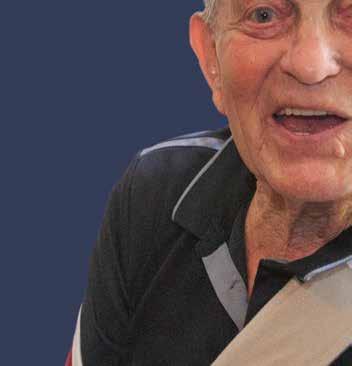




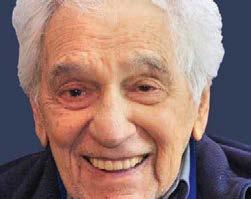

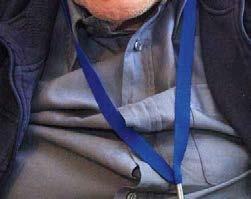
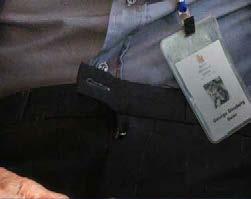

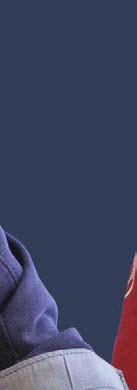
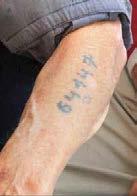



stories of resilience and survival From Auschwitz-Birkenau to Melbourne Centre News APRIL 2018 The magazine of the Jewish Holocaust Centre, Melbourne, Australia Registered by Australia Post. Publication No. VBH 7236
Sharing
JHC Board:
Co-Presidents
Pauline Rockman OAM and Sue Hampel OAM
Treasurer Richard Michaels
Vice-President David Cohen
Secretary Elly Brooks
Other Directors
Allen Brostek
Anita Frayman
Abr am Goldberg OAM
Paul Kegen
Phil Lewis
Helen Mahemoff
Melanie Raleigh
Mary Slade
The Jewish Holocaust Centre is dedicated to the memory of the six million Jews murdered by the Nazis and their collaborators between 1933 and 1945. We consider the finest memorial to all victims of racist policies to be an educational program that aims to combat
JHC Foundation:
Chairperson
Trustees
Helen Mahemoff
Nina Bassat AM
Joey Borensztajn
Allen Brostek
David Cohen
Jef frey Mahemoff AO
JHC Staff:
Executive Director War ren Fineberg
Curator and Head of Collections
Director of Education
Director of Community
Jay ne Josem
Lis a Phillips
Relations & Research Dr Michael Cohen
Director of Marketing and Development Leora Harrison
Director of Testimonies Project Phillip Maisel OAM
Librarian/Information Manager Julia Reichstein
Archivist Dr Anna Hirsh
Audio-Video Producer
Education Officers
Archive Assistant
Executive Assistant
Finance Officer
Office Manager
Communications Officer
Volunteer Coordinator
Bookkeeper
Database Coordinator and IT Support
Centre News:
Editor
Robbie Simons
Fiona Kelmann
Anatie Livnat
Fanny Hoffman
Claude Fromm
Evelyn Portek
Leon Mandel
Lena Fiszman
Tosca Birnbaum
Rae Silverstein
Daniel Feldman
Daniel Feldman
Ruth Mushin
Yiddish Editor Alex Dafner
13–15 Selwyn Street
Elsternwick Vic 3185
Australia
t: (03) 9528 1985
On the cover:
George Ginzburg and Josef Hellen
Photo: Elly Brooks
f: (03) 9528 3758
e: admin@jhc.org.au
w: www.jhc.org.au
OPENING HOURS
Mon–Thu: 10am–4pm Fri: 10am–2pm
Sun & Public Hols: 12pm–4pm
Closed on Saturdays, Jewish Holy Days and some Public Holidays
Disclaimer: The opinions expressed in Centre News are those of the authors and do not necessarily reflect those of the magazine editor or editorial committee. While Centre News welcomes ideas, articles, photos, poetry and letters, it reserves the right to accept or reject material. There is no automatic acceptance of submissions.
anti-Semitism,
and prejudice
and fosters understanding
IN THIS ISSUE From the Presidents 3 Editor’s note 3 Director’s cut 4 Education 4 Commemorating Holocaust Memorial Day in the United Kingdom 5 The power of speech 6 Mir zaynen do – We are here! 10 Saved by the courage of ordinary people 12 Josef Hellen and George Ginzburg: sharing stories of resilience and survival 14 Ties that bind 16 Echoes of Kristallnacht: antisemitism across borders 18 Melbourne’s Holocaust-survivor opsimaths 20 Child survivors remember 22 JHC Social Club 24 Friends of the Jewish Holocaust Centre 25 Seen around the Centre 26 The limits of expiation and atonement: a review of Solly Kaplinski’s A World of Pains: A Redemptive Parable? 28 Keeping the flame alive 29 New acquisitions 30 Community news 31
racism
in the community,
between people.
This publication has been designed and produced by Grin Creative www.grincreative.com.au
From the Presidents
pauline rockman oam and sue Hampel oam


Over tHe past few moNtHs, tHe JewisH HoloCaust Centre (JHC) has been a hive of activity, with exhibitions, book launches and international guest speakers. In September, together with other JHC Board members, we attended a seminar with Yad Vashem Holocaust historian Dr Dina Porat. The seminar was coordinated by Melbourne University’s Professor Leon Mann. Topics included ‘Is the Holocaust unique or one event in the genocide chain? and ‘Israeli and Jewish identity following the Holocaust’.
The JHC was presented with a Righteous Among the Nations medal and certificate awarded to Ids and Elizabeth Joustra. Their grandson Kyle Joustra decided that the award should be displayed where it could be viewed by many people, so that others could learn about his grandparents’ selfless deeds of rescue. We are most grateful to Kyle for this gesture.
The annual Betty and Shmuel Rosenkranz Oration was on delivered on Kristallnacht by Mark Weitzman, Director of Government Affairs at the Simon Wiesenthal Center in Los Angeles. His topic ‘Antisemitism Across Borders Today’, was confronting and powerful, leaving a capacity crowd with much to process. (An edited version of his address can be found on page 18 of this edition of Centre News ).
Also in November, A Point in Time was launched at the Centre to great acclaim. The third anthology of the Melbourne Child Survivors of the Holocaust Group, it features the life-affirming stories of 12 child survivors who give accounts of their lives before the Second World War, their experiences during the Holocaust, and their lives in Australia.
In late November the Australian delegation attended the plenary of the International Holocaust Remembrance Alliance (IHRA) in Bern, Switzerland. Members of the delegation were Australian Ambassador to Germany, Lynette Wood (Delegation leader), Pauline Rockman, Dr Steven Cooke, Dr Donna-Lee Frieze, Suzanne Hampel, Professor Suzanne Rutland and Dr Andre Oboler. Australia has had observer status at the IHRA since 2015, but at the Bern meeting, our membership was upgraded to liaison status. This means that Australia is now on its way to becoming a full member of the IHRA.
When the Australian delegates at the IHRA plenary entered the hall and the announcement of our new status was made, the other member countries applauded. This was a proud moment for the Australian delegation, not only because we are part of the IHRA’s important work, but also because our involvement enables us to maintain the legacy of our Holocaust survivors and keep the flame burning for future generations.
The United Nations International Holocaust Remembrance Day (UNHRD) commemoration was an event held jointly with
the Jewish Community Council of Victoria in January. Keynote speaker, the Hon Dr Brendan Nelson AO, gave an inspirational address in which he honoured Holocaust survivors. (See page 6 of this edition of Centre News ). A capacity crowd of over 350 attended the event. It is now 12 years since the JHC held the first UN Holocaust Remembrance Day commemoration in Melbourne, and it is pleasing to see that it continues to reach out to the wider Australian community. We look forward to the time when UNHRD is embraced by community organisations Australia-wide.
The JHC has lodged plans with the City of Glen Eira for the redevelopment of the Centre. Mazal tov to the Board and the building committee for achieving this milestone. While the State Government has contributed a considerable sum towards the project, we are preparing to embark on our campaign to raise additional funds so that we can begin to build our new centre.
Editor’s Note
ruth mushin
It is H ard to believe tH at tHis is tHe tweNtie tH editioN of Centre News that I am editing! Shaping this magazine has been an exciting journey for me, and one during which I have learnt so much and have had the privilege of working with so many wonderful people – especially the Holocaust survivors I have come to know, and those staff members at the Jewish Holocaust Centre who have helped and supported me. And for this edition it is a pleasure to welcome Alex Dafner as the new Yiddish editor and to thank him for his involvement.
In this edition, Mark Weitzman, from the Simon Wiesenthal Center, and Dr Brendan Nelson, Director of the Australian War Memorial, draw lessons from the Holocaust in discussing current events. We also bring you the stories of survivors Josef Hellen and Moshe Fiszman, and Bernadette Gore and Paul Valent, who feature in the new anthology of Melbourne child survivors, A Point in Time. Maarten Joustra recounts the moving story of how he was saved through the help and courage of ‘ordinary people’ in Holland, and Ellina Zipman discusses the Melbourne Holocaust survivor opsimaths – people who learn later in life – who embarked on study after being denied an education because of the Holocaust.
JHC Centre News 3
Education lisa Phillips Director’s cut warren fineberg
At last year’s eNd-of-year meetiNg for voluNteers, guides and staff, I reviewed some of the remarkable achievements of the Jewish Holocaust Centre (JHC) during 2017, as well as announcing that the plans for the proposed redevelopment of the Centre had just been lodged with the City of Glen Eira. We also screened a video prepared by JHC audio-visual producer, Robbie Simons, of seven JHC volunteers who passed away last year. It was a fitting tribute to Willy Lermer, Zyga Elton, Kitia Altman, Rosa Freilich, Sabina Josem, Saba Feniger and Masha Weiner.
The passing of survivors is an important reminder of JHC projects designed to ‘keep survivors’ voices alive’. These include Centre News feature articles, the new JHC Vimeo channel, the Memory Reconstruction Project, the VR (virtual reality) Project filmed with survivor Szaja (John) Chaskiel in Poland, and the Holocaust testimony recordings made as part of the Phillip Maisel Testimony Project.
Last year the popular Holocaust Education Program included a number of master classes particularly suited to experienced guides. The Guide Training Program for new guides, the on-going Professional Development Program and the 2017 Docent Guides Program at Yad Vashem ensured that our guides are well trained to deliver programs to students and members of the wider public.
The JHC curator and archivist have made significant progress in reviewing our artefact records to ensure we continue to maintain professional museum standards. Access to our collection is now available through JHC Collections Online, which is updated regularly. The Walter Preisser collection also underwent timely preservation thanks to the fundraising efforts of the Friends of the JHC.
From November to January we mounted Yad Vashem’s popular travelling exhibition ‘I Am My Brother’s Keeper’. The exhibition focused on the Righteous Among the Nations, with the addition of 14 local stories of Victorian residents who have been designated as ‘Righteous’.
The United Nations International Holocaust Remembrance Day commemoration, held in January, was attended by local, state and federal dignitaries. Dr Brendan Nelson, a wonderful supporter of Holocaust remembrance, delivered the keynote address, which you can read in this edition of Centre News
Readers of Centre News will have noticed the development of both the design and content of the publication over the years. Its high standard of professionalism is due to the superb skills of the editor, Ruth Mushin, to whom the Centre is truly grateful.
Iam ofteN ask ed tHe followiNg qu estioN iN my capacity as the Director of Education at the Jewish Holocaust Centre: ‘What are you planning for the future when there are no survivors?’ Although it is hard to imagine an education program that does not provide the intimate experience of meeting a Holocaust survivor, it is vital that we address this question in our planning.

Without a doubt the success of the Jewish Holocaust Centre (JHC) education program that attracted 22,000 students last year is the legacy of the survivors who established the Centre and its education program over 30 years ago. Despite modifications in framing the experience, it is the survivor testimony that leaves an indelible mark on those who attend. The late Kitia Altman, a long-time JHC survivor guide, once said: ‘No one can make any predictions about the future, but as long as people exist who understand the survivor and can pass the knowledge and the feelings of the survivors onto others, then the Holocaust will be remembered, both as part of Jewish identity and for its universal importance.’
Our challenge is to communicate the survivors’ knowledge and feelings. We will never be able to recreate the intimacy of meeting survivors, but we are confident that we can pass on their stories to future generations. Doing so will be different, but we are working hard to ensure that the experience will still be powerful, and that the survivors’ stories remain central to any of the programs we are currently developing.
We are fortunate that in 2002, Eileen Wright recognised the need to capture the survivors’ voices and embarked on the very important Eyewitness series. Her filming of survivors’ stories with an educational focus has provided us with vital material to work with in 2018. We are using that material in a variety of ways and supplementing it with the filming of new material. We are also drawing on the work begun by Zvi Civins, the previous Director of Education, in filming survivor responses to eighteen commonly asked questions by students, and the ‘Walk with a Survivor’ project, that JHC curator Jayne Josem is currently developing with film maker Danny Ben-Moshe.
Change is always inevitable, but with the rich resources available to us, we are working hard to ensure that we continue to honour the legacy of the JHC survivor community.

4 JHC Centre News
Commemorating Holocaust Memorial Day in the United Kingdom
Sue Hampel oam
IN tHe year 2000, tHe StoCkHolm DeClar atioN StateD: ‘We share a commitment to commemorate the victims of the Holocaust and to honour those who stood against it. We will encourage appropriate forms of Holocaust remembrance, including an annual Day of Holocaust Remembrance, in our countries.’
Five years later, the United Nations mandated 27 January, the date on which Soviet forces liberated the Auschwitz-Birkenau extermination camp, the international day of commemoration to remember and honour the victims of the Holocaust. The United Nations urged member states to develop educational programs to impart the memory of this tragedy to future generations, in the hope of helping to prevent further potential acts of genocide. In essence, this day was established so that people could learn about the past in order to create a safer, better future.
How will the Holocaust be remembered by future generations? How do we maintain the torch of remembrance that has been passed on to us by the last living survivors? These questions challenge and confront us. Perhaps the answer lies in the work being done by the International Holocaust Remembrance Alliance (IHRA), an intergovernmental organisation which unites governments and experts to promote, advance and shape Holocaust education, research and remembrance and to plant the seeds for a better future amidst the soil of a bitter past.
Australia is a liaison member of the IHRA and, as affirmed by Prime Minister Malcolm Turnbull, we look forward to taking our place on the world stage as a full member of IHRA in due course. As Australian delegates, Dr Donna-Lee Frieze and I were privileged to attend a number of events in the United Kingdom for Holocaust Memorial Day (HMD). This year’s theme focused on the power of words.
We crisscrossed the country, attending Holocaust commemorations in many diverse places, including the House of Lords – holding its first ever HMD event – the British Foreign Office, Mansion House, Westminster, local town halls, schools, libraries, churches, theatres and cinemas.

We discovered that in the month leading up to HMD, thousands of people attend at least one of the 8,000 commemorative events held throughout the country. In the United Kingdom, HMD is not only about remembering the Holocaust, but also a time to remember the millions of people murdered in the subsequent genocides in Cambodia, Rwanda, Bosnia and Darfur. During candle lightings and peace walks, tree plantings and poetry writing, people hear harrowing stories of the past and pledge to create a safer, better future.
There were many memorable events that we attended, but two stand out in my mind – the commemoration of HMD at the Foreign and Commonwealth Office, and the interfaith ceremony at Bolton Town Hall.
The Grand Locarno Suite in the Foreign and Commonwealth Office was the venue for an impressive array of speakers, including Australian-born Mark Regev, Israeli Ambassador to the United Kingdom; the Archbishop of Canterbury, The Most Revd Justin Welby; the Chief Rabbi of the Commonwealth, Rabbi Ephraim Mirvis, and the inimitable Boris Johnson MP. All speakers focused on the theme, ‘the power of words’. Rabbi Mirvis invoked Ecclesiastes 31:8 when he stated that ‘To everything there is a season – a time to keep silence and a time to speak.’ After the Holocaust, he said, many believed that silence was the only response to the murder of six million Jews. But silence is not the answer – we must speak with passion and use the power of words to build bridges of tolerance, mutual respect and unity.
The second meaningful visit was to Bolton, a town in Greater Manchester in northwest England. In the local town hall, over 150 people, including community, religious and civic leaders, as well as young primary school students, gathered at an interfaith service to commemorate HMD. Students read extracts from Anne Frank’s diary as well as poems and prayers. This town practises what it preaches by accepting refugees from conflict zones around the world. Bolton schools teach their students, from a very early age, the importance of working in partnership to enhance peace, harmony and trust between all people.
JHC Centre News 5
Sue Hampel OAM and Rabbi Ephraim Mirvis
The power of speech
brendan Nelson
United Nations International Holocaust Remembrance Day is held to accord with the resolution of the UN General Assembly proclaiming 27 January, the day in 1945 on which Auschwitz was liberated, as the annual international memorial day to mark the Holocaust. Co-hosted by the Jewish Holocaust Centre (JHC) and the Jewish Community Council of Victoria (JCCV), this year’s commemoration was held at the Glen Eira Town Hall. The keynote address was given by The Hon Dr Brendan Nelson AO, Director of the Australian War Memorial. This is an edited version of his address.
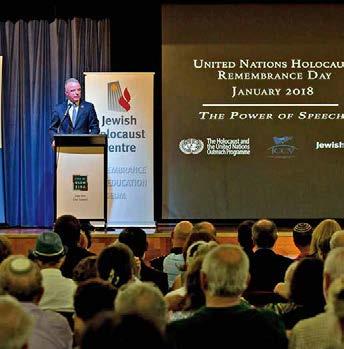
WHeN Soviet forCeS liberated auSCHwitz oN 27 January 73 years ago, they found some 7,650 barely living survivors, hundreds of thousands of personal effects, items of clothing and 700 tonnes of human hair. As many as 1.5 million people, mainly Jews, had been murdered by the Nazis.
In 2005, the United Nations General Assembly proclaimed the day on which Auschwitz was liberated as International Holocaust Remembrance Day. With humility and reverence, we remember and honour the dead, inspired by the triumph of the human spirit given us by those who survived. We do so in renewed commitment to one another, our nation and our ideals.
You do not necessarily realise what you are learning when you are learning it, and the most significant thoughts that have transformed my own perspective have often come in random and unexpected moments of quiet revelation.
The power is in the story. Late in 2012, having successfully applied for the position of Director of the Australian War Memorial, a close friend questioned why I would take up the position saying, ‘You have much more important things to do for Australia than rearrange its history.’ My reply was that this had much more to do with Australia’s future than its past.
In a world where humankind is moving to a new age as it did in the late 15th century, it is most important that we be clear about who we are, what we believe and the truths by which we live.
By any standard, the most important year in Australia’s history is 1788. The British First Fleet arrived with 1420 people, half convicts, including Jews. Although they devastated millennia of rich indigenous history, culture and custodianship, those events are the origins of the nation and people we have become.
The next most important year was 1942. Australia’s vital interests were at stake with the fall of ‘fortress’ Singapore; bombs falling on Darwin, Townsville and Broome; the gripping struggle along the Kokoda Track, Isurava and the repulsion of the Japanese at Milne Bay; Coral Sea, Midway, Guadacanal and Japanese midget submarines in Sydney Harbour. But also in 1942, a world away in the outer Berlin suburb of Wannsee, was a meeting convened by Reinhard Heydrich, the Reich Protector of Bohemia and Moravia. Heydrich had been appointed by Reich Marshal Göring as the plenipotentiary for the ‘Preparation of the Final Solution of the Jewish Question in Europe’, working with Himmler ‘without regard for geographic boundaries’.
In total, 11 million Jews would be targeted for extermination. Without a whimper, the 13 officials at Wannsee signed off on the ‘Final Solution’, the minutes recording their decision to ‘cleanse the German living space of Jews in a legal manner’.
This marked the darkest seminal moment in a series of events that would see the murder of 6 million Jews, abhorrence beyond the comprehension of our modern, comfortable lives. Also in 1942 British poet T.S. Eliot wrote these prophetic words:
A people without history is not redeemed from time for history is a pattern of endless moments
6 JHC Centre News
Hon Dr Brendan Nelson AO. Photographer: Sav Schulman
A nation that does not know or understand its history is dangerous, and the events of the Second World War have everything to do with our future and the people we strive to be.
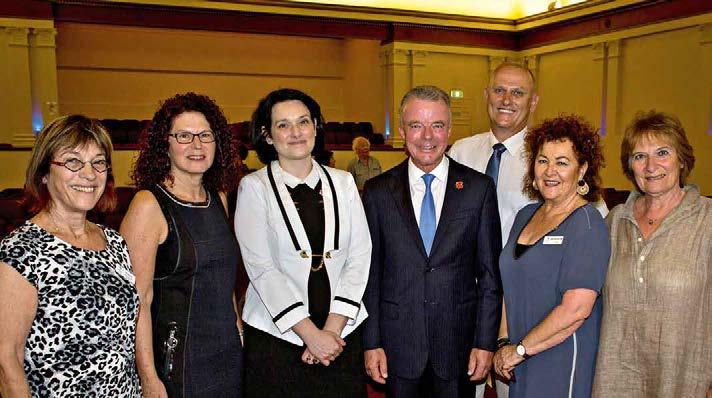
Australians all let us rejoice, for we are young and free.
We sing the first line of our national anthem often, but we pause less often to reflect on its meaning. Life’s paradox is that we tend to take those things most important to us for granted: the magic vitality of youth, unknown to us until it is gone; families that love us and give meaning to our lives; to be an Australian citizen, whether by birth or by choice, and with it the political, economic and religious freedoms we enjoy; to live in a nation in which faith coexists with reason, free academic inquiry, a free press and independent judiciary. And yet support for democracy is diminishing.
We are Australians not only because we have a constitution and the machinery of democracy given to us by the British. We are defined most by our values and beliefs, the way we relate to one another and see our place in the world. We are shaped by our heroes and villains, our triumphs and failures, the way we face adversity and respond to emerging unseen horizons.
Nations like people, face moments of truth – moments in history that challenge our very survival and values. Well led, we emerge stronger, more resilient, but if not, they may do us lasting damage. Those who survived and found their way to Australia in the aftermath of the Second World War made our nation. More than simply help our economic and social reconstruction, they nourished our better instincts, gave a greater belief in ourselves and a deeper understanding of what it means to be Australian.
I have visited Washington many times and, irrespective of time constraints, I always visit two places. One speaks to the ideals of mankind, the other to the evil darkness into which we are capable of descending.
The first is the Jefferson Memorial. Thomas Jefferson was first Secretary of State and third president of the United States, a giant of man, notwithstanding his views on slavery. Enshrined in marble are the words he crafted for the American Declaration of Independence:
We hold these truths to be self-evident: that all men are created equal, that they are endowed by their creator with certain inalienable rights, among these are life, liberty, and the pursuit of happiness, that to secure these rights governments are instituted among men.
Jefferson wanted to be remembered not for the holding of position or power, but for co-authoring the American Declaration of Independence and the Virginia Statute for Religious Freedom, and for founding the University of Virginia. He saw the founding of the university as his single most important legacy because, in his words, ‘Education is the defence of the nation.’ More than anything else, education is likely to protect us from ideas and attitudes deeply rooted in ignorance and prejudice.
From Jefferson I always go to the Holocaust Museum. There, some exhibits in particular stand out, such as the thousands of shoes, and the video footage of Nazi doctors experimenting on the insane and physically disabled. Highly educated professionals who crossed the threshold in 1930s Germany, believed some people’s lives of so little value they could be ended with state sanction. Then there are the hundreds of black and white photographs of men, women and children looking out from lives never lived.
On the second floor is a photograph of Rosa Goldenzeil, a Hungarian woman who arrived with her daughters at Auschwitz in the spring of 1944. As selection commenced on the rail platform, she quickly grasped the situation. Rosa turned to her daughter holding her baby saying, ‘They are saving any women with children, give me the baby.’ Rosa knew by her own age that she was already dead, as was the baby. What moral courage did she draw upon to make the decision to save her own daughter and in doing so give up her own life and that of her cherished grandchild? In this, Rosa was like so many others.
Six million Jews were murdered in an act of unspeakable genocidal barbarism. So too were homosexuals, Roma, gypsies, the disabled and political dissidents.
It is tempting to settle for the broad brushstrokes of history – the headlines, popular imagery and mythology. Our comfortable lives breed easy indifference to individual
JHC Centre News 7
(l-r) Elly Brooks, Sue Hampel OAM, Dorit Herscovici, Hon Dr Brendan Nelson AO, Svetimir Ristich, Pauline Rockman OAM and Helen Mahemoff. Photographer: Sav Schulman
acts of courage, lives given in the name of all that is good, a triumph of the human spirit in death.
A year after I took up this role I had one of the most meaningful experiences of my life, let alone my tenure as Director of the Australian War Memorial. When staff proposed a temporary exhibition of artworks by Alan Moore, one of the Memorial’s Second World War Official War artists, his name meant nothing to me.
Alan Moore had been commissioned as an official Australian War artist, deployed first to the South West Pacific in 1944 and then to North Africa and Europe. Following enquiries, I found he was living in a Victorian nursing home. At the age of 99, he was able to come to the Memorial to view works he had not seen for 60 years and which had never been exhibited together. He arrived in a jacket and cravat, wearing the beret he had worn through his war service.
As I pushed him in his wheel chair to view the exhibition, he spoke with emotion about his works from the South West Pacific, northern Africa and during a V2 Rocket attack in London. When we then stopped at three confronting works, he trembled. Alan Moore was with the British when they liberated the Bergen-Belsen death camp in April 1945. He gestured to a charcoal drawing of SS guards removing dead women and children from a railway carriage to a burial pit. ‘The Welsh guard, the Welsh guard,’ he whispered. ‘I was drawing this and the Welsh guard told me no one will believe it. He was right, so I got my camera and took photos.’
The second work portrayed nondescript buildings and a perimeter fence, with a stooped figure standing in the midst of multiple objects on the ground. Alan said, ‘The blind man … the blind man with the stick. He was walking amongst the dead and didn’t know.’
Until that day I did not know that this was the first time these works had been hung at the Australian War Memorial, despite Alan Moore having been commissioned as an official war artist. When I asked why, I learned that he had been told repeatedly that people ‘are not interested in the Holocaust.’
I found that only seven small images made up what was told of the Holocaust in the Australian War Memorial galleries. When I told our staff we would construct a permanent Holocaust exhibition, not everyone was happy. One critic said emphatically, ‘This has nothing to do with Australia and the Australian War Memorial. You are breeching your charter. I will never walk through it.’
‘Why,’ I asked, ‘do you think we were fighting the Second World War at all if not against Nazism and fascism? This has everything to do with us, for we are part of humankind.’
In a world grappling with the mass movement of people, the persecution of political, ethnic and religious minorities, the push for euthanasia and a generational struggle against resurgent totalitarianism principally in the form of Islamic extremism, we must remind ourselves not only of why we fought wars, but that of which humankind is capable and the circumstances that lead to it.
The ‘Holocaust: Witnesses and Survivors’ opened late in 2016. The exhibition presents the Holocaust through the stories of survivors who made their new lives in post-war Australia. We present the rise of Nazism, the Wannsee Conference, transportation, the horrors of the gas chambers, ghettos and persecution. The raw, powerful drawings of Bernard Slawik
present a harrowing and deeply personal account of the callous, bureaucratic killing of the Jews of Lvov, and of his internment in the Janowska concentration camp. Artefacts, documents and relics from Melbourne’s Jewish Holocaust Centre have enabled us to bring individual stories of suffering and survival to life. Finally, Alan Moore’s works at the liberation of Bergen-Belsen are now permanently and proudly displayed.
In my opinion Jewish identity has been shaped by three forces: antisemitism, which remains a repugnant force in far too many people in many parts of the world; the Holocaust or ‘Shoah’; and the daily existential struggle of the State of Israel in a region dominated by theocracies and autocracies.
Antisemitism is not just a feature of modern history. When the Roman Empire embraced Christianity, antisemitism played a catalytic role in building the foundations of the religion that would supersede Judaism. The Christianity that largely defined European civilization used antisemitism at various times to meet its political and theological objectives. And antisemitism at different times has been seemingly ubiquitous, found in major religions, the political left and right, amongst the educated and the illiterate poor.
In the 19th century, scientists drove a fascinated culture of order and control, and race emerged as a feature of the nation state. Populist perceptions rooted in race ran in parallel with social Darwinism and eugenics. The First World War heralded the introduction of industrialised killing on a scale never before seen.
Then, the bitter hardships experienced by Germans after the First World War radicalised antisemitism. The Weimar Republic from 1919 to 1933 legitimised violence as a form of control that was acceptable to the educated, upper classes. Hitler was able to take advantage of two key things: the first that the majority were indifferent to the plight of the minority; and the second that in Germany, as in other parts of Europe, antisemitism was deeply rooted.
Antisemitism did not end with liberation of the death camps, the end of the war, the Nuremberg trials, nor the formation of the United Nations. Anti-Zionism, Holocaust denial, distortion of truths, and the glorification of Nazism have all featured in the world since. Today troops are deployed across Europe protecting synagogues and Jewish places of congregation. Fire bombings, desecration of cemeteries and other violations are real and present dangers. In recent years, crowds have chanted ‘Gas the Jews’ and ‘Death to the Jews’. Only three years ago the United Nations General Assembly debated antisemitism.
Socrates in 400 BC concluded that ignorance is the root of all evil and Jefferson echoed a similar sentiment. But of the 13 German ministers and senior public servants at Wannsee, nine had the best university education Europe had to offer. Adolf Eichmann, Heydrich’s henchman in charge of implementing the ‘Final Solution’, said at his trial that Heydrich had expected bureaucrats to oppose the plan, but instead they embraced it with enthusiasm.
It is more than education. It is character. Character derives from the Greek word meaning the impression left in wax by a stone seal ring. The Greeks called it ‘the stamp of personality’. It transcends rank, power, money, influence, looks and intellect, and is informed by values, worthwhile intrinsic virtues.
8 JHC Centre News
In my opinion, ethical and responsible citizenship relies on three things. First, a minimum level of education, including scientific literacy, is required for people to understand and be resilient to change, including new technologies.
Second, we all need to be imbued with what Professor Graeme Davison described in ‘The Uses and Abuses of Australian History’ as ‘the imaginative capacity to see the world through the eyes of others’. Almost all of life’s pain and suffering in my experience stems from people and nations making themselves the centre of their own world.
Third, people need to be imbued with a deep value system that informs character. As both Benjamin Franklin and Edmund Burke observed, ‘Men must be virtuous and have strength of character to enjoy freedom.’
The stories of survivors and the qualities embodied in their humanity and spirit are powerful guides to the future. Among their values are physical and moral courage, endurance, devotion, independence, loyalty, honesty, love of others and never forgetting from where you come, who gave you what you have and made you who you are.
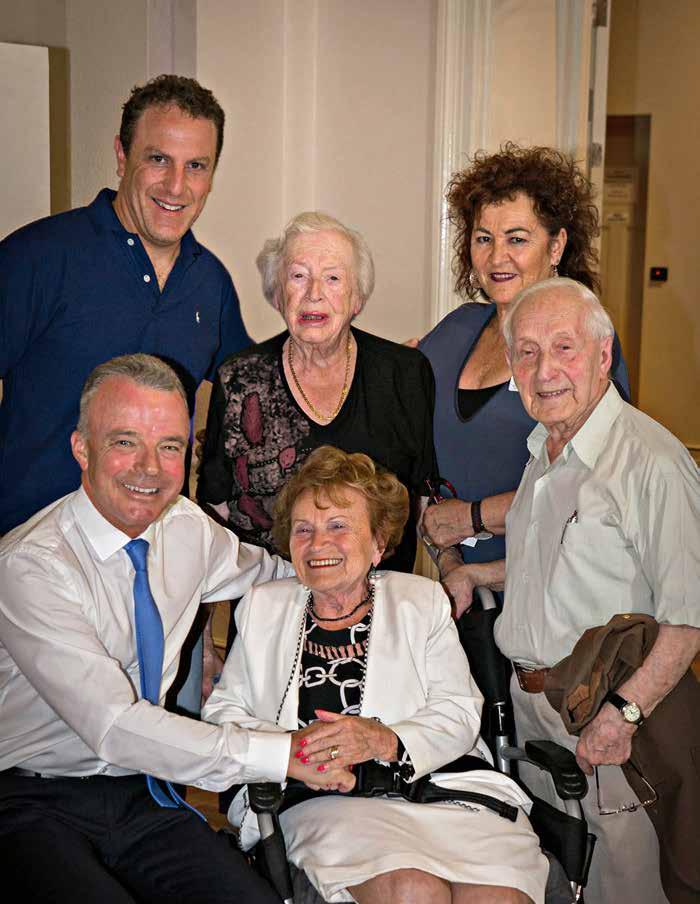
The responsibility we all share is to make these stories live and engage a new generation, and museums are vital to our common future.
Our political class must lead us to where our best selves need to go and provide a vision that is human and social as much as it is economic. Even if all economic and scientific problems were ever solved, important questions would remain unanswered.
Hope is the most powerful yet fragile of human emotions. We all have to believe that tomorrow will be better than today, not only for ourselves, but those whom we love and our country.
Israel is not a perfect country, none is, but in my opinion it is the repository of that fragile yet powerful human emotion – hopeful belief in freedom and a better future. It is a nation built on belief in political, religious and economic freedoms, and the equal treatment of all faiths and peoples. Yet every day, Israel has to justify and fight for its existence – politically, diplomatically and militarily. It seems we live in a world of fundamentalist intolerance and moral relativism. My grandparents fought and defeated fascism in the 1930s and 40s, my parents’ generation stared down communism. We now face a resurgent totalitarianism, principally but not only in the form Islamic extremism. Disparate groups have hijacked the good name of Islam to build a violent political utopia, opposed to the equal treatment of women and the liberating power of education.
We live in vast ignorance of the decisions we make and that are made for us, facing global uncertainty and immense technological change. What we need most is one another.
The Holocaust and those who survived it teach us many things: the importance of commitment to one another and belief in what is right; of conscience and knowing the right thing to do and when to do it; feeling the pain of others and seeing the world through their eyes. Most importantly they inspire us to have the moral courage, irrespective of personal consequences, to act on what in our hearts we know to be right.
In the words of the great 18th century Prussian philosopher Immanuel Kant:
Every human being is an end unto to himself and not a means to be used by others. Respect for one’s own humanity will be found in respect for the humanity of others – and morality is freedom.
That is, doing what you know to be right on the basis of respect for the humanity in others will make you truly free. Failure in this will render us blind to injustice, deaf to despair and indifferent to the future … for we young and free.
JHC Centre News 9
(l-r) back: David Cohen, Irma Hanner and Pauline Rockman OAM, front: Hon Dr Brendan Nelson AO, Cesia Goldberg and Abram Goldberg OAM. Photographer: Sav Schulman
Mir zaynen do – We are here!
My pareNts gave me tHe N ame m osHe at tHe time of my birth in Poland, towards the end of 1921, but during the Holocaust I was to become Prisoner Number 25627 and later, in Dachau, Prisoner Number 150321. The Nazis’ aim was to dehumanise me – to deprive me and countless others of our identities, but I refused to abandon the name my parents gave to me – a name which I bear along with the great biblical leader, Moshe, known in English as Moses.

Moses and his Israelite followers who were oppressed by Pharaoh and his army were forced to wander from Egypt through the Sinai desert, from Ramses to Sukkot and Eitam and then onward to Marah and other places. Together with my people, I was also forced, by a modern-day Pharaoh and his collaborators, to wander: from Radom, my place of birth, to the Nazi hellholes of Majdanek, Auschwitz-Birkenau, Natzweiler-Struthof, Vaihingen and Dachau.
Unlike the Israelites of old, there was no divine ‘pillar of cloud’ to protect us; there was no manna from heaven to sustain us; and there was no divine revelation, as with Moses at Mount Sinai, to give us strength, support and hope. We were met with what appeared to be divine indifference, or simply silence.
During our wanderings, they took our homes, our possessions, our clothes, our shoes, even our hair. When we spoke, no one listened and, if they listened, they did not understand. They took our names and our identities and, for those of us who survived, our loved ones. On the Jewish Day of Atonement we recite the words, mi yichyeh u’mi yamut (who will live and who will die) –affirming that decisions about life and death lie in God’s hands alone. Those decisions, however, were wrested from the hands of the divine by the Nazi devil incarnate during the Holocaust.
My ‘journey’ mirrored that of many thousands of victims of the Nazis. After four long years of suffering, starvation and slave labor, having our families murdered, the remnants of the once 30,000 Jews of Radom were forced on a six-day death march, after which we were herded onto cattle trucks, to arrive at the Birkenau extermination camp. The death march took place in July, at the height of summer. We did not stop for water, and anyone who could not keep up with the guards was killed. After reaching Birkenau and having gone through the infamous selections, we were loaded onto cattle trucks. We ended up at Vaihingen, a camp in Württemberg, to join thousands of other slaves of different nationalities to build an underground aircraft factory for the Messerschmitt Company.
Our only hope of being liberated by the Soviet forces had disappeared when, after reaching the Vistula River, they stopped, giving the murderers enough time to take us deeper into Germany for further slave labor.
As Jewish prisoners we had to perform the worst manual labour, carrying sacks of cement on hanging ladders 70 metres down a quarry. On a ration of only 200 calories per day, hundreds lost their lives from exhaustion and malnutrition. In one mass grave alone over 1,600 prisoners lie buried.
10 JHC Centre News
moshe Fiszman
Moshe Fiszman. Photographer: Sav Schulman
By the end of 1944 our food rations were reduced to a bowl of watery soup and a loaf of bread, shared between eight prisoners. We began work at five in the morning and ended at nightfall. We were liberated some five months later, after being taken to Dachau and then marched, in the bitter cold, into the Tyrol Mountains – and abandoned.
My wife Franka’s journey was little different: from Plaszów to Auschwitz-Birkenau, Bergen-Belsen, and then to Mauthausen, where she was liberated. Franka turns 98 this year. A victim of typhus, her survival was a miracle – and, for me, a blessing.
Returning to the analogy of Moses and the divine revelation at Mount Sinai, the Exodus, what we call yetzi’at mitzrayim, witnessed the emergence of Jewish nationhood and the fulfilment of the divine promise of a Jewish homeland. And it was very shortly after my wanderings, and that of my people who survived the unspeakable Nazi terror, that the world finally acknowledged that we too deserved a home where, over the last seven decades, we have created a wonderful vibrant democracy.
On 4 September 2003, three Israeli air force F-15 Jets flew over Auschwitz-Birkenau as part of a special ceremony. The jets took off from Radom, where I had been taken prisoner and where my community was decimated some 60 years earlier. The pilots and their crew were all descendants of Holocaust survivors, and they carried with them the names of Holocaust victims.
The flyover was a tribute to the memories of the victims of the Holocaust. The message of the flyover mission was clear: unlike the Allied forces during the Second World War, who patrolled the skies above the death camps but refrained from bombing Auschwitz and its railroads for ‘lack of resources’, Israel will never leave Jews to their fate.
The leader of the Air Force jets, Major-General Amir Eshel, transmitted a message from his cockpit to the ceremony taking place below:
We pilots of the Israeli Air Force, flying in the skies above the camp of horrors, have arisen from the ashes of the millions of victims. We shoulder their silent cries, salute their courage and promise to be the shield of the Jewish people and its nation Israel.
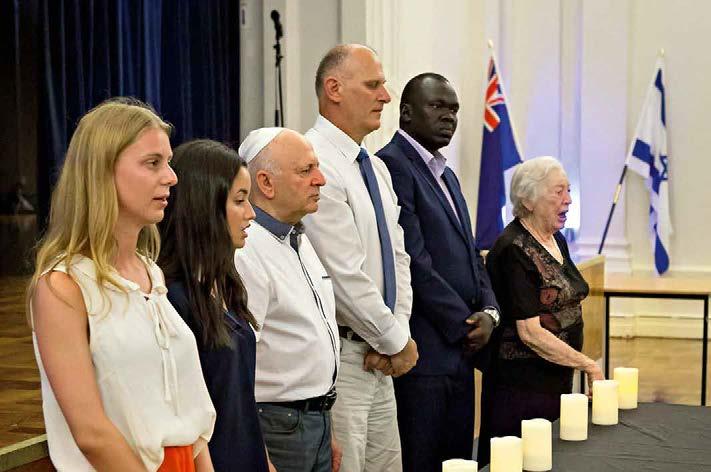
In the words of our Partisans’ Song – mir zaynen do! Never again will we be victims.
Am Yisrael chai!
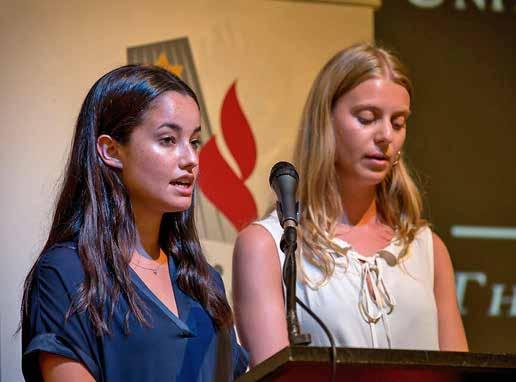
JHC Centre News 11
Moshe Fiszman is a Holocaust survivor and guide at the Jewish Holocaust Centre. This is an edited version of his address at the United Nations International Holocaust Remembrance Day commemoration held in Melbourne in January 2018.
(l-r) Bianca Saltzman, Mandy Meyerson, Gennady Vilkhov, Svetimir Ristich, Richard Deng and Irma Hanner. Photographer: Sav Schulman
(l-r) Mandy Meyerson and Bianca Saltzman. Photographer: Sav Schulman
Saved by the courage of ordinary people
maarten Joustra
The Jewish Holocaust Centre recently held the special exhibition ‘I Am My Brother’s Keeper: Honouring the Righteous Among the Nations.’ This travelling exhibition from Yad Vashem (The World Holocaust Remembrance Centre in Jerusalem) tells the stories of nonJews who, at great risk to their own lives and those of their families, saved the lives of Jews during the Holocaust. The State of Israel has honoured these people with the title ‘Righteous Among the Nations’. In January 2018 Ids and Elizabeth Joustra received Righteous medals posthumously for their role in saving a Jewish baby whose name they changed to Maarten. Here is an edited version of the speech Maarten Joustra gave at the exhibition launch.
Over tHe yea rs I H ave Hear d ma N y sur v I vor s’ stories. Although they are all very different, many share one underlying element – they would not be here to tell their story if it had not been for the help and courage of ordinary people who cared not just for the Jews, but for all people persecuted by the Nazis.
I was born on 10 June 1943 in Amsterdam as Alter Heimann. I am the only survivor of my immediate family – grandparents, parents and siblings. Between 1941 and 1945, 59 (possibly more) members of my family were murdered. Only five survived, two of whom are alive today.
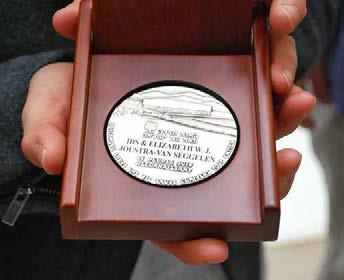
My parents were in hiding when I was born, as was my tenyear-old sister Sarah, who was somewhere else in Holland. As Sarah was very homesick she decided to rejoin her family but unfortunately she did not make it. She was arrested and deported to Auschwitz and was murdered three days later.
Within a month of my birth I was separated from my parents and ended up at a railway station, along with around 100 babies and young children. On that particular day Mia Smits née van Seggelen rode her bike to the station as she had been doing for a few months. She looked pregnant and appeared to be getting bigger with each visit to the station. However, on this day she finally came to do what she and a group of resistance workers had been planning for several months – to save a Jewish child. It was my lucky day!
With some help she removed the padding that made her look pregnant and replaced it by hiding me under her clothing. She walked calmly out of the station, put me in the wicker basket on her bike and took me to her home in Harlem. She gave me the name of Maarten, a very old Dutch name, and looked after me until February or March 1944, around the same time as my mother and father were transported to Auschwitz and murdered soon after.
Mia – or Tante (Auntie) Mia to me – worked with a resistance group established by Corrie ten Boom. Corrie’s family, members
of the Dutch Reform Church and deeply religious, held Jews in deep respect. They saw the wrong that was happening around them and turned their home in Harlem into a safe house, offering money, food and short-term shelter for up to six Jews at a time. With the help of others, the organisation grew and established a small network of safe houses known as the Beje movement. It is estimated that they saved the lives of 800 Dutch Jews.
In February 1944 the ten Boom family was betrayed by a Dutch informant and the whole family was arrested. I met Corrie in the 1960s when she came to Australia as an evangelist and she told me that out of the 100 children and babies on that platform in 1943, only seven survived.
When the ten Booms were betrayed, Auntie Mia became increasingly worried about my safety as she believed she could also be betrayed. When she asked her family if they could find somewhere safer for me, her sister Elizabeth and her husband Ids Joustra offered to help. As Ids also spent a lot of his time in
12 JHC Centre News
Righteous Among the Nations medal awarded posthumously to Ids and Elizabeth Joustra
hiding – he was an active resistance fighter wanted by the police and Nazis – his hiding place was quite secure.
It was not easy to look after me during that period as it was difficult to get food and milk, and I was sickly and needed medical care. This was even more difficult as I was not registered as part of the Joustra family. When someone asked who I was, the answer was that I was the child of a relative from Rotterdam whom Elizabeth and Ids Joustra were looking after while my parents looked for a place to live. This was believable as Rotterdam had been bombed extensively and many residents were displaced.
We made it through the war and in 1948 Elizabeth and Ids Joustra applied to become my guardians. I became known as Maarten Joustra and acquired a whole new extended family of grandparents, uncles and aunts, as well as parents and siblings. I have wonderful childhood memories.
In 1951 my foster family migrated to Australia in search of a better life. I was eight years old when we arrived, and I was Maarten Joustra for everything, with the exception of official documents. When we all became Australia citizens I officially changed my name to Maarten Joustra, although my name on my Dutch passport is Alter Heimann, and this remains very precious to me.
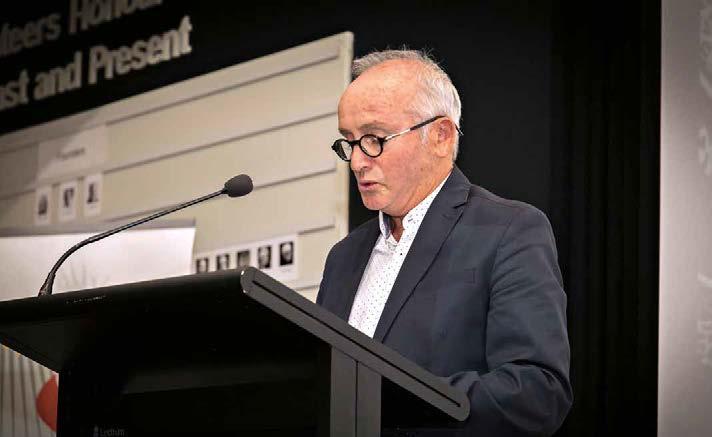
To the credit of my foster family, I always knew that I was a Jewish child who had lost most of his family during the war. My foster father would constantly tell me I was Jewish and special, and made an effort to connect me to other Jewish people.
When I was about 12 my father was working for a Jewish family. With their help, it was decided to send me to a Jewish home for displaced children in the Melbourne suburb of Balwyn so that I could learn Hebrew and prepare for my bar mitzvah. However, I missed the loving environment of my family and only stayed there for two months.
My parents smothered me with love and, for most of the time, I could do no wrong. My sister is the only remaining member of my immediate family, as my parents and brother have passed
away. I am close to my nephew Kyle, who helps me with my research into my birth family. His father – my brother – would have been very proud of him. Over the years I have stayed in close contact with my foster family in Holland and have visited them often. My ‘saviour’, Tante Mai, passed away in her 90s.
I have never stopped searching for living members of my birth family and, with Kyle’s help, have found two distant living relatives: one living in Israel an one living in Amsterdam. One sent me a photo taken before the war of some Jewish people at a market stall in Amsterdam as he thought that my parents may be part of that group. The Jewish Museum in Amsterdam is working to put names to all the faces in that photo and, if they are able to identify my parents, this would be the first picture I would have seen of them.
About two years ago a volunteer at a Jewish aged care facility in Amsterdam made contact on behalf of a Holocaust survivor who thought she may be related to me. Her name is Nette Eggers and she is a first cousin, the daughter of my mother’s sister. We have spoken and exchanged photos and, seeing a photo of her as a very young child with her brothers and sister, there is no doubt that we are family as her youngest brother looks very much like I did at the same age. With the exception of her mother who died of natural causes shortly before the war, her whole family, including five brothers and sisters, was murdered by the Nazis. Although Nette survived, she had a more difficult time during the war than I did. My wife Kerry and I plan to go to Amsterdam this year and I hope that meeting Nette will bring some closure for us both.
I often asked God: ‘Why me?’ After all that has happened, I was given a new family, my beautiful wife, Kerry, two wonderful daughters, Joanna and Kate, and three grand daughters Molly, April and Pearl, as well as some wonderful friends. My story has taught me not to judge people by their race or religion, but by their individual deeds. I hope that we can open our hearts to those trying to come to this great country in search of nothing more than a reasonable life for their family – as my family did all those years ago.
JHC Centre News 13
Maarten Joustra. Photographer: Dean Golja
Sharing stories of resilience and survival
ON a seemi N gly o rdi N ary day i N November 2017, two men who only knew each other by name and fragments of shared history met for the first time in Melbourne. Joseph Hellen had read George Ginzburg’s memoir and wanted to meet him to discuss elements of their shared past. What transpired was both unexpected and overwhelming. From two different backgrounds, these two men discovered that they had arrived in Auschwitz within the same 24-hour period. Both men survived the Holocaust in very different circumstances and ultimately settled in Melbourne where they rebuilt their lives. In November 2017 they met for the very first time and exchanged stories of resilience and survival. Nearly seven decades after their lives were bound together by circumstance, the two men explored their shared past and vivid memories of endurance and persistence, to not only survive but to thrive in Melbourne following the darkest period in Jewish history.
Both men have published their memoirs. George’s titled A Will to Live: A Story about Hope and Strength of the Human Spirit was published in 2007 and Josef’s, titled AuschwitzBirkenau: University of Life in 2017. The ramp is an extract from Josef’s story.
Josef Hellen was born in Hodonín, Czechoslovakia, in 1926. Nicknamed ‘Pepik’, he had an older brother and two younger sisters. In August 1942, police walked into his classroom and ordered Josef and four other Jewish boys to come with them. He never saw his family again. Josef ended up in Canada (‘Land of Plenty’) Commando in Auschwitz, which sorted the luggage brought by Jews and sent back to Germany. Josef unwittingly ensured his survival by teaching an SS officer to throw knives. Soon he was cleaning the SS’s boots and even helped to form a soccer team. Canada was right beside the gas chambers and the workers witnessed tens of thousands walking between the barbed-wire fences to their death. Josef escaped from a death march and found refuge in a Polish family’s barn until the area was liberated by Russian forces. He then made his way to Hungary where he met his wife Judith, also a Holocaust survivor. In Australia, Josef worked hard to save money to buy his first milk bar. This was the beginning of what was to become a property empire, both in Australia and in the United States. The Hellen Wing of the Emmy Monash Homes and the Evelyn Hellen Library at Bialik College honour his daughter, who died of leukaemia at seventeen. His son and daughter both work for the family company.

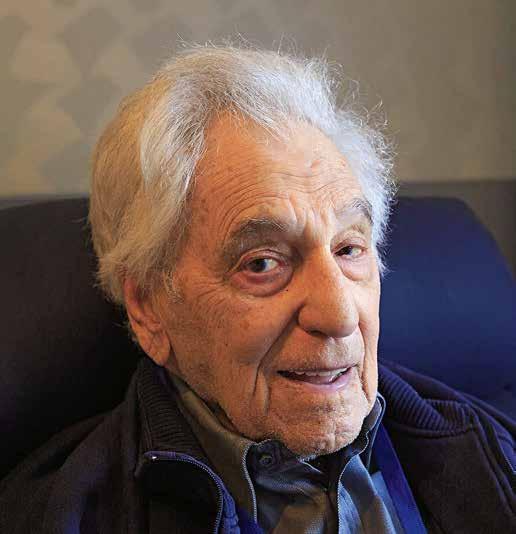
14 JHC Centre News
George Ginzburg. Photographer: Elly Brooks
Josef Hellen. Photographer: Elly Brooks
The ramp
I spent my first few weeks with the Canada Commando working on the arrival ramp. I was the youngest there. We wore white scarves around our necks, tucked into our striped jackets. Our job was to take the luggage out of the wagons after the people had all left and pile it onto waiting trucks. It was hard work.
The SS watched us closely and we were not allowed to speak to the people on the trains. If anyone spoke to them he was taken behind the trains and shot with a silencer on the pistol. The SS did not want the already traumatised families arriving on those trains to become even harder to deal with, as they would have been if they saw any of us being shot. There was to be no panic.

The people coming out of the wagons were not screaming and yelling because they had no idea where they were or what happened there. They were also very tired and weak, after having spent days in the wagons, and they had small children with them. They could not imagine that they were about to be murdered. All the SS on the ramp had big Alsatian dogs with them, which were trained to bark and snap at the Jews.
Selection was very quick, very simple. Women with children under sixteen and people over fifty were automatically directed to one side.
When I had the chance, I opened some luggage and saw there was plenty to eat, though you had to be careful not to get caught. Otherwise you got twenty-five lashes on the bottom. You also had to run non-stop with the bundles and load the trucks going to Canada. ‘Los! Los! Raus! Schell! ’ (Out! Hurry!) We were screamed at all the time.
One transport from Lithuania was held up somewhere for a couple of weeks in the middle of summer and everyone on the train had died. The bodies were all swollen and black and blue and the smell was something I can never forget. We were ordered to pull them out of the wagons and load them onto trucks that would take them straight to the crematorium to be burned. We had no gloves. I pulled at one hand and it just fell off. I vomited many times that day, which was the hardest day of my life. It took us all day to empty the train. The SS usually hung around new arrivals so they could steal something, but this time they stayed far away and just shouted to us to hurry, hurry!
Both George Ginzburg and Josef Hellen’s memoirs are published by ‘Write Your Story’, a cultural activity begun by the Makor Jewish Community Library, now part of the Lamm Library of Australia.
JHC Centre News 15
George Ginzburg and Josef Hellen’s Auschwitz numbers. Photographer: Elly Brooks
Ties that bind viv Parry
I have been a volunteer at the Jewish Holocaust Centre (JHC) for 18 years, much of that time spent with the Child Survivors of the Holocaust. For eight years I have also had the privilege of running the weekly art group for Galiamble Aboriginal Men’s Recovery Centre, a program for Aboriginal men in recovery. I am often asked how I have come to support two seemingly unrelated communities, but understanding my early years might provide the answer.
Iwas bor N to a Holo C aus t survivor motHer w Ho escaped Berlin with her parents and younger sister after my grandfather’s dental surgery was destroyed on Kristallnacht, November 1938. From the early 1930s my grandfather, realising the family might have to flee Germany, had been hiding the gold he used for fillings. He made the gold into jewellery, something to sell if need be. I still wear one of the gold bracelets.
Arriving in Australia in early 1939, the family faced serious issues that left my mother as the breadwinner at the age of 19. When her health deteriorated, she was sent to Mildura in northern Victoria to recuperate. There her outlook on life took a turn for the better when she met the local Aboriginal community. The Aboriginal women allowed her to sit with them as they created traditional paintings, and my mother returned to Melbourne with a deep respect for the Aboriginal people and their culture.
Marrying our father – who had served in the Air Force in PNG during the war – the memories of Nazi Germany remained to haunt my mother, who decided not to raise her children in the Jewish tradition, for fear of reprisal. At the same time, she brought us up to admire and respect the Aboriginal people and their traditions. Dad contributed with stories and songs from PNG, and built us a traditional PNG native hut in our suburban backyard. Looking back now it was a unique upbringing and I am ever grateful.
It was little wonder that I landed at the door of the Galiamble Centre bearing clothing and other items contributed by members of the Jewish community, who have always supported my community work. As Galiamble focuses on rehabilitation and culturally relevant recovery, I asked Mark Hammersley, the manager, if he would allow the men to visit the JHC to learn about William Cooper and Kristallnacht. He immediately agreed, and so I set about creating a program that informed the men about the Holocaust, an event about which few Aboriginal people are aware. The William Cooper Holocaust Program commenced in 2011 and continues to this day.
Holocaust survivor and JHC guide Moshe Fiszman was pleased to share his testimony with the men and his story has proved inspirational for them. I had also come to know William Cooper’s grandson, Uncle Boydie, and had listened to his stories about his
early childhood at Cummeragunja in the care of William Cooper, his grandfather. Cooper lead a delegation of the Australian Aboriginal League to the German Consulate in Melbourne in 1938, to present a petition against the events of Kristallnacht in November 1938, and Uncle Boydie has been passionately committed to continuing his grandfather’s legacy.
The impetus for the film Ties That Bind: From Auschwitz to Cummeragunja came from my wish to bring Uncle Boydie and Moshe Fiszman together, with the broader aim of honouring two ancient peoples, connected by a deep understanding of each other’s terrible past, together with the desire to honour William Cooper. Ties That Bind finally became a reality with the help of the JHC audio-visual producer, Robbie Simons, who did the filming, and Justin Olstein, the producer and editor. The haunting music that concludes the film was composed by Mordechai Gebirtig, who was murdered by the Nazis in 1942. It has been specially recorded by violinist Boris Savchuk in honour of members of his family who were murdered in the Holocaust.
In conjunction with the launch of the film, the JHC held an exhibition of artworks painted by the men from Galiamble in response to their visit to the JHC, meeting with a Holocaust survivor, and learning about William Cooper and the connections between Aboriginal people and the Jewish community. Most of these men have never painted before, but after making a start with tentative brush strokes, they have gone on to produce vibrant and thoughtful works of art, reconnecting with tradition and telling their stories through art. Some have left Galiamble with a new skill at which they excel, and three are currently undertaking tertiary studies in Aboriginal art and culture.
Ties That Bind: From Auschwitz to Cummeragunja, directed by Viv Parry, was launched at the Jewish Holocaust Centre in July 2017, in conjunction with an exhibition of Holocaust-inspired art by men from the Galiamble Aboriginal Men’s Recovery Centre, and with a didgeridoo performance by Stan Yarramunua. The film is available from The United States Holocaust Memorial Museum, Washington. For further information please email Viv Parry: vivparry@bigpond.com.
16 JHC Centre News
D B Williams (Kunggari), Coming Together, Acrylic on canvas (2017)
My concept shows half the painting representing the Aboriginal people using dots of red, black and yellow. The other half of the painting represents the Jewish people in blue and white. Using the traditional signs for journey and meeting places I have shown each community crossing over into the other community’s land. The star in the centre is shown as the meeting place where both sides come together as one shared community.

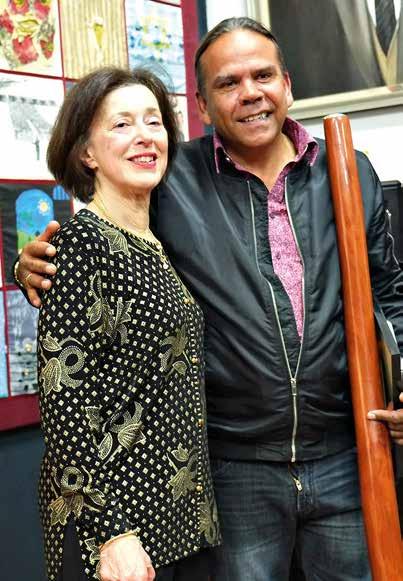

Joshua Birtwistle (Yamitji) Cultures aligned, Acrylic on canvas (2017)
The star is the sign of the Jewish people and the colours I have chosen are the Jewish traditional colours, blue and white. The dot technique I have used is an important traditional way of painting for Aboriginal people. I wanted to show the two cultures aligned.
JHC Centre News 17
Viv Parry and Stan Yarramunua
Echoes of Kristallnacht: antisemitism across borders
mark Weitzman
Just as the Nazis made their antisemitism truly global, antisemitism today respects no borders and threatens us all. The pamphlets and radio broadcasts of Nazi Germany beamed across the world have morphed and multiplied dramatically in an age of digital communications, especially through the new platforms of social media. Just as important, however, is the distortion of the Holocaust and its antisemitic implications, especially in the political and legal institutions that control our lives.
THe impaC t of tHe Holo C aus t a N d tHe seCoN d World War have helped shape the foundations of our world, being the basis of the creation of bodies like the UN and the European Union, establishing legal precedents for defining and prosecuting war criminals charged with genocide and crimes against humanity, and helping to create the eventual acceptance of human rights.
Yet today we are facing a reality where in some Western countries that experienced the Holocaust and claim to be allies of Israel, countries which officially commemorate the Holocaust and even some where Holocaust denial is criminalised, are now officially attempting to distort the history of the Holocaust by whitewashing local collaborators and minimising or even removing the Jewish identity of the victims. These countries include Croatia, Hungary, Ukraine and Russia.
However, in no country today is the situation more acute than in Poland. There we find senior government officials, such as Minister of Defense Antoni Macierewicz claiming in 2002 that he had read the infamous Protocols of the Elders of Zion and that: ‘Experience shows that there are such groups in Jewish circles.’ Two other cabinet members, Foreign Minister Witold Waszczykowski and Culture Minister Piotr Gli´nski have also declined to condemn the Protocols when asked to do so. Macierewicz’s 2002 statement was given to Radio Maryja, the notorious antisemitic radio station that has been condemned by the Vatican for its anti-Jewish remarks, and referred to in the 2008 US State Department’s Global Anti-Semitism Report as ‘one of Europe’s most blatantly anti-Semitic media venues’. In 2016 one commentator on the station stated that ‘the Jewish Lobby in Poland demonstrates its racial solidarity with the Ukrainian oligarchs’, and later claimed that ‘The U.S. media and entertainment industry are dependent on the Jewish lobby. It is similar to the Stalinist terror, which was organised and implemented by Jewish communism.’ During a trip to the US the same commentator, among other antisemitic remarks, referred to the ‘Jewish faction’ that allegedly is ruling Poland. It is bitterly ironic then that this allegedly Jewishrun government subsidises Radio Maryja, reportedly paying out the staggering sum of over seven million dollars, and
even issued a postage stamp to commemorate the station’s 25th anniversary.
Perhaps worst of all, a new law states that:
Article 55a. 1. Whoever publicly claims, contrary to the historical facts, the Polish Nation’s or the Polish State’s responsibility or partial responsibility for the Nazi crimes committed by the German Third Reich …or for any other crimes against peace, crimes against humanity, or war crimes, or otherwise grossly diminishes the responsibility of the actual perpetrators of these crimes, shall be liable to a fine or imprisonment for up to 3 years… Article 55b. Notwithstanding the legal framework applicable in the jurisdiction where the illicit act was committed, this Act shall apply to Polish citizens and to aliens in the event of committing any of the crimes referred to in Articles 55 and 55a.
Thus, according to this law, since Poland was occupied by Nazi Germany during the time of the Holocaust, any person who makes a statement referring to Polish collaboration or complicity in the murder of the millions of Jews killed on Polish soil is committing a crime. This is not a totally new initiative, as Poland is already trying to move against the eminent Princeton University historian Jan Gross. Gross, who previously received the Polish Order of Merit in 1996, is the author of Neighbors (Princeton, 2001), which tells of the murder of several hundred Jews in the town of Jedwabne by their Polish neighbours on 10 July 1941. The book was a National Book Award finalist in the US in 2001 and caused a major controversy in Poland where its findings were hotly debated, but did lead two presidents of Poland to apologise for what happened at Jedwabne. In an interview with a German newspaper in 2015, Gross stated that in his opinion Poles killed more Jews than Germans during the war (a statement that is supported by many leading experts but is highly controversial in Poland). This led to Gross being investigated on the charge of libeling the Polish nation under the law ‘that any person who publicly insults the Polish nation is punishable by up to three years in prison’. He has since been hauled in for five hours of questioning, and the threat continues to hang over him. Indeed, the first prosecutor assigned to his case recommended dropping it, but was overruled by his superior in
18 JHC Centre News
what appears to be a political decision. As an esteemed senior scholar at Princeton, Professor Gross will not suffer from this attempt at censorship of inconvenient history. However, the full impact of the law will have a chilling effect on less established and younger scholars, who may fear to speak openly on their ndings, or be dissuaded from even beginning to research the subject of Poland and the Holocaust. It will also dissuade others, such as teachers, clergy, members of the media or anyone who publicly refers to the established historical record. This is clearly an attempt to legislate history.
Equally frightening is with this proposed amendment becoming law in March 2018, anyone in any place – not just Poland – who is convicted of ‘shaming’ Poland’s reputation in relation to the Holocaust faces a potential three-year prison sentence.
Consider the words of Sigi Isak, born in Berlin and a survivor of the Plaszów labor camp and Gross-Rosen concentration camp: ‘ … they were terrible before the war the Poles. (I) even call them worse than the Germans because they did ugly things in the war.’ Or of Lonia Mosak, born in Poland and a survivor of Auschwitz, who remembered that ‘we decided we’re going back to Poland. …We didn’t realise that Poland was worse than with the Germans. They didn’t want any Jew to come there because then they claim their properties. So they didn’t want us. So when you went out on the street, you saw laying dead Jews.’ Or of Melbourne’s own Abraham Kolski, born in Lodz, Poland, and a survivor of the Treblinka death camp who said: ‘I don’t say one hundred percent Poles are bad …and maybe a ten percent (of the) Poles are good. The other, even today, very very bad. You can’t imagine. You can’t imagine. You are an American. You can’t imagine. They are worse than the Russians. They are worse then the Germans.’
I have heard many similar statements – the testimony of Holocaust survivors who felt the sting of personal relationships
fatally betrayed, who have recounted their emotions and experiences and now, under this proposed new law, are potentially facing criminal charges at this late stage of their lives.
Political distortion of the Holocaust can also be found in the US. There was an immediate outcry over the White House’s 2017 statement on Holocaust Memorial Day that omitted any mention of Jews. President Trump then spent over an hour in April at the Holocaust Museum’s Yom HaShoah event, which was unprecedented for a sitting President. However, he later caused controversy by appearing to embrace the Polish nationalist narrative during his rst visit to Poland where he became the rst President since 1989 not to visit the Warsaw Ghetto Memorial.
These dispiriting events raise the question of what our world has learned since the Holocaust. Have all the efforts of remembrance, memorialisation and education had any impact? Is the situation hopeless and are we powerless? The answer is no – we are not powerless and we can ght back against intentional amnesia and distortion.
From the evidence of survivors and witnesses, and even of the perpetrators, we must challenge the distortions of the history of the Holocaust, and from their lessons we must commit to being open to antisemitism and hatred. By being open to the reality of those messages and using them to strengthen our resolve we may yet be able to build a better future. And to that goal we pledge to continue to strive.
In November 2017 the Jewish Holocaust Centre held the Betty and Shmuel Rosenkranz Oration at the Glen Eira Town Hall. The oration was delivered by Mark Weitzman, Director of Government Affairs at the Simon Wiesenthal Centre, Los Angeles, USA. This is an edited extract of the oration.
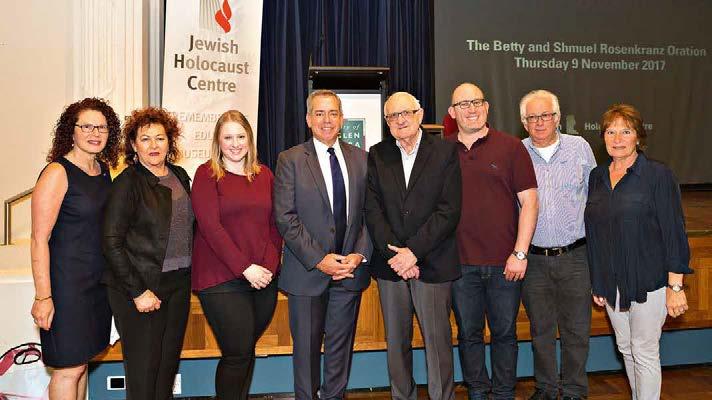
JHC Centre News 19
(l-r) Sue Hampel OAM, Pauline Rockman OAM, Terry Lazarus, Mark Weitzman, Leon Goldman, Jonathan Lazarus, Ron Rosenkranz and Helen Mahemoff. Photographer: Zina Sofer
Melbourne’s Holocaustsurvivor opsimaths
Ellina Zipman
People who begin formal learning later in life are called opsimaths, from the Greek word opsi meaning ‘late’ and maths, which means ‘learner’. While researching material for my PhD that focuses on older people learning new skills, I came across the interesting phenomenon of Jewish Holocaust survivors (speci cally in Melbourne) who returned to study in their retirement and pursued higher degrees after their obligations to their families were ful lled.
MELBOURNE IS THE HOME TO A LARGE NUMBER OF Holocaust survivors and home, too, to refugees from Nazi Germany who migrated to Australia before the outbreak of the Second World War. Survival was foremost on most people’s minds, and there was no question of education at that time. For those who settled in Australia after the war, the need to make a living and support their families took precedence over any academic pursuits they may have undertaken before Hitler came up with his Final Solution.
In his autobiography, The Long Road to the Lucky Country (Makor Jewish Community Library 2005), Leo Cooper, a tter and turner turned academic, currently a resident of Gary Smorgon House in Melbourne, discusses the trend among Holocaust survivors to pursue educational quali cations: ‘I wasn’t alone in the endeavour for further education. A number of Jewish Holocaust survivors, who had come to Australia at about the time I did, shared similar ideas and pursued various kinds of intellectual activities, and some with notable success.’
Leo Cooper names some family friends who ‘picked up’ learning in retirement. The late Sonia Kempler, for example, dedicated her life after the war to raising a family and to her husband’s business. However, when family obligations allowed her, she returned to study, obtaining a Bachelor of Arts degree at Melbourne University in 1975. The late Max Kestin, who was 15 when war broke out, returned to study in retirement, rst gaining his Higher School Certi cate (now Victoria Certi cate of Education), and then receiving a law degree from Monash University at the age of 65. Among Leo’s other friends who pursued education in their later years were the late Jacob Rosenberg, well-known author and poet and a survivor of the Lodz Ghetto; Peter Hall, a belt manufacturer who attained a doctorate; and Jacques Adler, a baker turned historian. Leo notes that all these people
shared ‘common experiences in surviving the Nazi horror’ and ‘a common tradition that puts a strong emphasis on learning and education.’
In the Jewish tradition literacy of children was a priority. All boys were taught to read and write from the age of three. With this in mind, it might be not appropriate to call these people opsimaths, as they were literate in many areas but without formal quali cations. One early opsimath, in the strictest sense of the word, may be said to be Rabbi Akiva. One of the most signi cant Jewish scholars in history with over 24,000 followers, he was unable to read or write until the age of forty. At the insistence of his wife Rachel, who made it a condition of their marriage that he studied, he embarked on the journey of learning, initially mastering the alphabet and reading together with his son, and later pursuing knowledge at various academies for a period of 24 years.
It has not been uncommon among Melbourne’s Jewish Holocaust survivors to pursue formal educational quali cations when they were able to do so. Many have completed the Victorian Certi cate of Education (or earlier Year 12 equivalents) and then continued to pursue tertiary studies.

Leo Cooper was the rst opsimath I met. We met at the Passover Seder table several years ago, where the hostess introduced him as a scholar who read and analysed the whole of the Koran. Later, when I began my PhD research which hypothesises that ‘an old dog can learn new tricks’, I considered Leo as a potential resource.
Leo Cooper lived three lives: before the Holocaust, after the Holocaust in Europe and Australia, and the third as a matureage academic. Known rst as Lolek, then as Lyova and nally as Leo, he was born in Poland, exiled to Russia during the war, then returned to Poland after the war, where he found nothing
20 JHC Centre News
Leo Cooper PhD
Leo Cooper and family
familiar. After searching for a new life in France and Belgium, he finally made his way to Australia.
Leo had attended a technical school in Poland where, at the age of 17, he became a fitter and turner, a trade that helped him survive the war years in Russia. His second long-term occupation was as the owner of a small business in Australia, but when his business shut down due to Labor Government reforms, he began to consider a new occupation. At the age of 53 he returned to secondary school. Since then he has completed his Higher School Certificate, Bachelor of Arts Honours degree and a PhD, lectured at university, worked as a Senior Fellow at Melbourne University’s Contemporary Europe Research Centre and published eight books.
Jacques Adler, who survived the war in France as a teenager, arrived in Australia and from 1947 until the late 1970s worked in business to support his family. Later in his life he pursued an academic career, gaining his doctorate at Oxford University and publishing The Jews of Paris and The Final Solution The Sydney Morning Herald of 13 October 2017 aptly describes Jacques Adler as a ‘politically engaged historian, who found his vocation after a long detour.’
Abram Biderman, a survivor of four Nazi concentration camps, came to Australia in 1949 without a word of English. Having made a career in the schmatte business, he was forced into early retirement by Labor’s economic policies and pursued a literary career. His survivor’s testimony The World of My Past was initially self-published in 1995 when he could not find a commercial publisher. However, in 1996 the book was selected by the National Book Council for the CUB Banjo Award for nonfiction, as well as for the biennial biography award. In 1997 the book received the Banjo Paterson Prize and Victorian Premier literary award and was later republished by Random House.

Israel Kipen, a notable Melbourne Jewish community personality, also did not have the opportunity to complete his education because of the war. Arriving in Australia in 1946, he became
involved in business and community work. He contributed to the development of Jewish day school education in Melbourne, including taking part in the group that established Mount Scopus Memorial College. Later, he became a president of Bialik College and played a major role in its development. While working tirelessly to provide educational opportunities for Jewish people in Melbourne, Kipen’s personal aspirations were put on hold. At 57, he retired from business and decided to return to study. In his autobiography, A Life to Live, Kipen writes: ‘The notion of retirement was both psychologically and existentially unacceptable to me. I knew that I wanted one thing more in my life. That was to make good the lost opportunities of the past and resume tertiary studies.’ When he received his Bachelor of Arts degree, his achievement was celebrated in the media as ‘Degree – 44 years later’. Kipen then completed a Master of Arts degree at the University of Melbourne, worked as a university lecturer and received an Honorary Doctorate of Letters for his contribution to education.
Despite being denied the opportunities of a formal education during their younger years, fleeing war and persecution, migrating, and making a life in a new country with a new language and culture, many Holocaust survivors managed to carry their passion for learning into their older years and make the courageous step to embark on formal education. ‘Having enrolled,’ writes Leo Cooper, ‘I felt not only happy, but also proud of myself. I was especially proud that the desires I had nurtured since my childhood were becoming reality.’ He writes later, when his Master’s thesis was upgraded to a doctorate, that he was ‘looking forward to the day when even at this late stage, I might be called “doctor”.’ Referring to his parents, he thought ‘of how proud they would be to see their son achieving such a high level of education.’
JHC Centre News 21
Ellina Zipman is a PhD candidate at Monash University.
Child survivors remember

A Point in Time, the third anthology of the Melbourne Child Survivors of the Holocaust Group, is the culmination of a series of interviews with twelve child survivors who recount their pre-war life, Holocaust survival, fresh start in Melbourne and subsequent contributions to their new homeland. At times shocking and heartbreaking, their stories are also life-affirming. Here are extracts from two of the stories:
 Ber N adette Gore: Fra NCe
Ber N adette Gore: Fra NCe
My earliest memories are of a happy life living with my family in a small village in the countryside. My Papa works in the village, while Maman is at home with us girls. I have a little playmate my own age called Denise, just across the road.
Then, when I am almost six years old, men in black cars come to our house and hold a gun to Papa’s head. His face is white and his eyes are filled with terror. Maman screams and tries to resist, but they hit her with their guns. We are all marched out of the house at gunpoint toward their waiting cars, but for some reason I manage to run away.

It feels like I run for ages until I reach Denise’s house. Her mother, Madame Carreau, keeps me safe. In the week I spend in their warm and loving home she makes two beautiful dresses for me. One has tiny pink flowers and little cap sleeves and the other has pretty blue flowers. But someone comes to the house asking for a Bernadette and she is too afraid for her own daughters’ safety to keep me hidden.
So, I am taken to a nearby orphanage called ‘Villa Robert’. In my mind, it’s a huge place behind a high, grey brick wall with many children. I show the children that I can make handbags and, for some strange reason, sunglasses. On my return years later, a longterm memory of climbing cherry trees and the distinct, almost sour, taste of the small yellowish pink fruit is finally placed here.
From the orphanage I am taken to a small remote cottage in the countryside. The people who live here are called Paul and Catherine Porcher. In my mind this is my House of Horrors and that woman will always be ‘The Witch’. I will never forget her voice. She tells me my new name is Bernadette Laurent and that I must not tell anyone that I am Jewish or I will be killed. It’s the first time I hear this word, but quickly learn that being Jewish is a very bad thing.
One night, as I’m getting ready for bed, she discovers me praying for the safety of my parents and my sisters. The Witch tells me it’s no use praying because they are all dead now. That night I wet the bed and when I come downstairs they both laugh at me. There is another boy hiding with me in the cottage too. He is smaller than me and I am told I must teach him to read. The Witch says that if he makes a mistake I must slap him. Deep in my heart, I know that he also endured much pain in this house and his little face still haunts me to this day.
There are no happy memories of my time here. My fear has blanked out the abuse I suffered, but despite our desperate living conditions, that little boy and I did have some fun together. I remember being woken often by heavy fighting and artillery fire nearby. In the darkness we have to dress quickly and go down to the cold, cramped cellar. One night we put each other’s clothes on and giggle quietly behind our hands about this silly game we’re playing.
22 JHC Centre News
Bernadette Gore and family
Bernadette Gore (centre) with her sisters
One day a truck with a large red cross on the side comes to take me away. But the woman driver is wearing a uniform, so I am very scared. ‘No, you are German and you have killed my mother!’ I scream, but despite my protests I am picked up and placed in the back of the truck. The woman has come to pick up the sick and wounded to take them to Limoges Hospital, but in the end, I travel alone.
Soldiers open the doors to check that there are no partisans hiding on board. I crawl into a ball and try to make myself as small as possible.
Eventually, I am reunited with my mother and sisters, who have been released from jail. Maman picks me up and I pinch her face to see if she is real. She looks like my mother but very pale. I tell her she needs lipstick. I am filthy, dressed in rags and infested with lice. Maman is also very ill. After a period of recuperation we are reunited with my father who was being held captive by the Milice and we all return to Les Vignes.
Paul ValeNt: SloVak ia
May 1942
We have been walking for a while now. It’s dark and we can hear dogs barking in the distance, which causes some worry, but Dad is carrying me on his shoulders so I feel safe. I am not sure where we are going, but my parents keep telling me to be quiet, not to speak. I can sense that this is serious and so I obey.
We arrive in an unfamiliar place. We are in a flat in Budapest and I am introduced to my great aunt. She and my parents tell me that I have a new name, that I have new grandparents and give me a new story to tell about my life and who I am. My parents stress to me that I must not speak Slovak anymore, only Hungarian from now on.
Paul Valent and family
It is impressed upon me that these things are extremely important and that I must remember them and do as I have been told.
(Whilst Slovakia had begun deporting Jews to Auschwitz, Hungary was not yet persecuting Jews, only illegal immigrants, thus the need for me to speak only Hungarian and repeat the story of my newly fabricated life.)
Budapest, later in 1942
This is a point in time when things changed irrevocably. We have left the flat on Pannonia Street. When we are in the street, two men in trench coats approach my parents. They are having a conversation, but I can’t hear what they are saying. My mother turns to me and tells me they are going with these men to get some ice cream and they will bring it back soon. I watch as they walk to the end of the street and turn right to the ice cream shop. I watch them all the way, but my mother never turns back to look at me – and then they are gone.
(In fact my parents were arrested and put into jail. They were then taken to the border where they were handed back to the Slovaks who in turn put them in cattle cars bound for Auschwitz. In Žilina, the last stop before Auschwitz, my parents heard their names being called and were taken off the train by guards who had been bribed by one of my uncles. They made their way back to Hungary and, after they retrieved me from the farm where I had been taken, we lived as Aryans for the remainder of the war in Budapest.)


Budapest 1942
I am on a train with my uncle Jani, my mother’s brother. My parents did not return from the ice cream shop. My uncle and I are travelling to the family farm where he and another uncle worked before they were taken to labour camps, and where my aunts and their children still lived.
‘When we wee, we will sit down like women,’ my uncle says to me on the train to the farm.
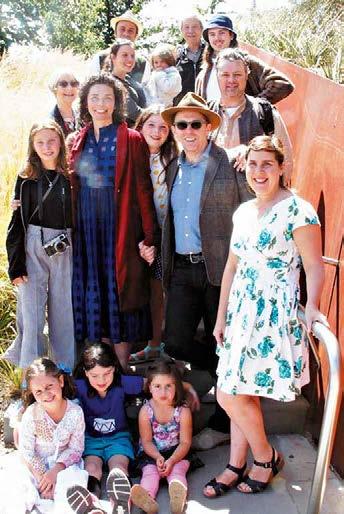
I will stay on the farm a while, I am told.
(In 1992 I travelled back to the farm where I was hidden for months after my parents had been taken away. I didn’t remember the house, but I did remember the outhouse and the field of corn I could see next to it. I found a woman on the farm who remembered me. She remembered me wanting to go to school like the other children, but I was not allowed and so, she told me, I used to pick walnuts during the day and hide them in my pockets. She took me to the tree. I did not remember it, but when I touched the walnuts I remembered their feel in my hands.)
JHC Centre News 23
A Point in Time: Third Anthology of the Melbourne Child Survivors of the Holocaust is available from the Jewish Holocaust Centre.
Paul Valent and his mother
JHC Social Club
Barbara sacks
HoloCaust survivors, voluNteers aNd guides, together with their friends, meet monthly at the Jewish Holocaust Centre (JHC) Social Club. The Club continues to attract stimulating and informative speakers, and participants take part in lively discussion after each presentation.

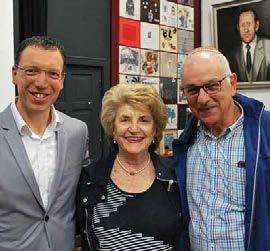

Over the past few months, the Social Club has addressed a wide range of subjects, ranging from international and community issues to more personal stories. In August 2017, Lilly Skurnik OAM spoke about her life and her memoir, The Colours of Life Living Blind. Having led a wonderful life in spite of her blindness, Lilly is a passionate advocate for people with disabilities and an inspiration for both those with vision impairment and for sighted people.
Dr Danny Lamm AM presented a lecture on ‘Israel and the Middle East: Prospects for Peace.’ As president of the Zionist Federation of Australia since 2014, and having been involved in a range of Jewish community organisations – local, national and international – for many years, Dr Lamm was well qualified to tackle such a complex subject.
Bill Appleby, CEO of Jewish Care (Victoria) and a strong advocate for value-based leadership and the development of a ‘good society’, spoke about ‘Jewish Care’s Capital Development Program and how this investment will allow Jewish Care to better serve the community’.
Returning to global issues, Dr Dvir Abramovich address was titled ‘Now is the time! Fighting antisemitism and the global war against
Israel’. As chair of the B’nai B’rith Anti-Defamation Commission and Israel Kipen Lecturer in Jewish Studies and Director of the Program in Jewish Culture and Society at The University of Melbourne, as well as the author of four books, Dr Abramovich gave a thoughtprovoking analysis of this difficult topic.
Our next speaker, Adele Hulse, returned to the more personal, speaking about ‘An amazing life: embracing Buddhism and penning Holocaust survivor memoirs’. Coming from country Victoria, embracing Tibetan Buddhism as a young person and becoming a writer (as Sharon Gray) of a regular column in The Age for many years, Adele is now involved in the Lamm Jewish Library of Australia (formerly Makor) ‘Write Your Story’ program, facilitating the publication of Holocaust survivor memoirs.
The JHC Social Club attracts between 45 to 60 people regularly, and welcomes members of the community to attend for bagels and coffee, and for stimulating and lively discussion. The Club meets monthly on Thursday mornings at the Jewish Holocaust Centre.
For further information about the JHC Social Club, please contact Barbara Sacks on 0404 224 498.
24 JHC Centre News
(l-r) Barbara Sacks, Annetta Abel, Pauline Rockman OAM, Adele Hulse, Lucia Haberfeld and Wolf Deane
(l-r) Dr Dvir Abramovich, Barbara Sacks and Elyau Golshevsky
(l-r) Maya Lee, Lilly Skurnik, Tanya Fox and Barbara Sacks
Friends of the Jewish Holocaust Centre
Elly Brooks
THE FriENds oF tHE JEwisH HoloCaust Centre committee meets regularly and is committed to providing practical and financial support for the Centre’s social and educational programs. We achieve this through our membership drive, fundraising functions and volunteering to assist at events at the Centre.
Our committee is a wonderful group of dedicated people: Goldie Birch, Elly Brooks, Sabbie Berger, Vivienne Golabek, Annette Hayman, Sue Lewis, Rosi Meltzer, Rhonda Norich, Alice Peer, Cynthia Spicer, Lauren Spitalnic Majtlis, Linda Spitalnic and Edna Vexler. Mandy Myerson and Bianca Saltzman attend committee meetings, representing Young Friends of the JHC.

Goldie Birch has resigned as co-president, as her growing family is now located far and wide around Australia and she has additional commitments. We thank Goldie for her hard work as president, and look forward to her continuing involvement on our committee. Congratulations, too, to committee member Sue Lewis and to Mary Slade for each receiving The 2017 Volunteer Recognition award from the City of Glen Eira last.
On UN Genocide Day on 9 December, I attended an annual multicultural and multifaith commemoration organised by the City of Darebin to remember victims of genocide and other atrocities. Dr Donna-Lee Frieze, JHC Genocide Studies Scholar, was the keynote speaker. I was privileged to light a candle and read a verse on behalf of Holocaust victims.
The Young Friends group, headed by Mandy Meyerson and Bianca Saltzman and their committee, held a function for young people in conjunction with JCCV at Beth Weizmann Community Centre. Attended by 50 tertiary students and seven Holocaust survivors, the students broke into small groups, each with a survivor who told their story and answered questions. It was a heartfelt morning during which the young people who attended enjoyed engaging directly with elderly survivors.
The Friends committee encourages new supporters to become involved and attend our functions. We thank all who have supported our work during the year and look forward to bringing our members a range of exiting new in the coming year.
Become a Friend of the Jewish Holocaust Centre & support the activities of the Centre.
The Friends of the Jewish Holocaust Centre plays an important role in providing financial support to the Centre through membership subscriptions, raffle book sales, sales of the Entertainment Book and social fundraising functions.
To become a Friend of the Jewish Holocaust Centre, simply download and complete the form from jhc.org.au
For further information please contact Elly Brooks on (03) 9528 1985 or email ellyhbrooks@gmail.com
JHC Centre News 25
(front l-r) Lauren Spitalnik, Goldie Birch, Elly Brooks, Rosie Meltzer, Sabbie Berger, (back l-r) Linda Spitalnik, Sue Lewis, Annette Hayman and Rhonda Norich
Seen around the centre

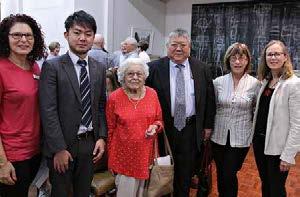






26 JHC Centre News
➊ ➋ ➌ ➑ ➐ ➏ ➍ ➎
➊ (l-r) Prof Hariz Halilovich and His Excellency Mr Mirza Hajric, Ambassador of BosniaHerzegovina to Australia
➋ (l-r) Jayne Josem, Hans Van Meurs, Peter Van Meurs, Sue Hampel OAM, David Cohen, Peter Kilburn and Pauline Rockman OAM
➌ JCCV Jewish Immersion Day for Imams and Muslim community leaders
➍ (l-r) Rae Silverstein, Warren Fineberg, Julius Sevcik and His Excellency Dr Bernhard Zimburg, Austrian Ambassador to Australia
➎ (l-r) Abram Goldberg OAM and Prof Christopher Browning
➏ (l-r) Donna Fryde, Norman Fryde, Vivien Dobia, Maurice Dobia and Helen Feniger

➐ (l-r) Merav Michaeli MK and Sue Hampel OAM
➑ (l-r) Shota Tohara, Hannelore Hauser, Yoshimitsu Kawata, Elly Brooks and Jayne Josem
Photographer: Julius Sevcik
➒ (l-r) Moshe Fiszman and Prof Peter Balakian
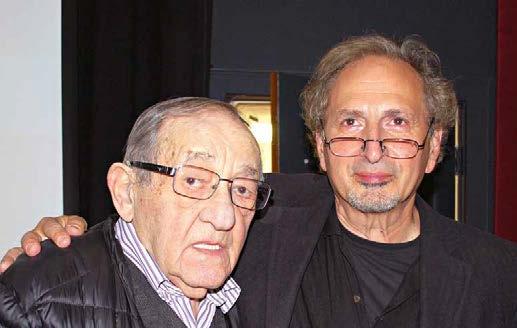
➓ (l-r) Sue Hampel OAM, Mary Slade, Prof Leon Mann, Prof Dina Porat and Pauline Rockman OAM
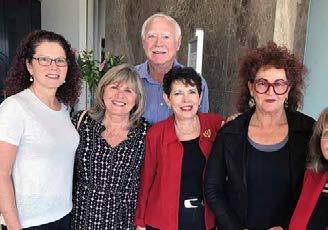
� (l-r) Lisa Phillips, Andy Factor, Henri and Sandra Korn
� (l-r) Danuta Jurkowska and Bella Shulman
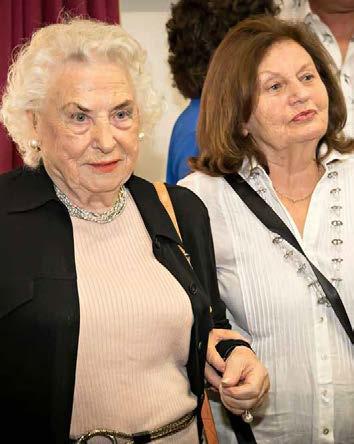
JHC Centre News 27
➒ ➓ � �
The limits of expiation and atonement
A review of Solly Kaplinski’s A World of Pains: A Redemptive Parable?
 Michael Cohen
Michael Cohen
IN HIS FOREWORD TO SOLLY KAPLINSKI’S A World of Pains: A Redemptive Parable?
(CreateSpace Independent Publishing Platform 2015) Dr Stephan D Smith, OBE, USC Shoah Foundation Executive Director Chair, refers to the novella as a thought-provoking thriller. Rather than a thriller, Kaplinski has written what is essentially a midrash – a term used by early rabbinic authorities to make interpretive connections between new Jewish realities and the unchanging biblical text. The source of Kaplinski’s ‘text’ or parable, however, is not the Bible; it is, in the broadest sense, the Holocaust.
The phrase ‘a world of pains’ appears in a letter by the English poet John Keats (1795-1821) to his siblings and refers to what Keats called ‘a place where the heart must feel and suffer in a thousand diverse ways.’ It is a tting title.
Born in Cape Town, and a long-time resident of Jerusalem, Kaplinski worked for several years at Yad Vashem after a stellar career as a principal of Jewish day schools in South Africa and Canada. He is currently director of the American Joint Distribution Committee’s Overseas Joint Ventures and has served in that capacity for the last 12 years.
Kaplinski has turned his hand from writing poetry to penning a novel set against the background of the Holocaust. His rst book, poems published by Credo Press in 1992, was titled Lost and Found – A Second Generation Response to the Holocaust
The ease with which the narrative of A World of Pains: A Redemptive Parable? unfolds in no way obscures its profundity. Kaplinski is not only steeped in the history of the Holocaust; he is also a clinical psychologist and, through the novella, explores the complexities of moral behaviour and responsibility (or otherwise), the limits of man’s conscience, the functions of the sub-conscience, and the issue of suppressed memories.
The story begins in October 1942 in the Ponar (Ponary) forest, some 10 kilometres from the centre of Vilna where, between 1941 and 1944, an estimated 100,000 people were massacred by the Nazis and their collaborators. The overwhelming majority of the victims were Jews. The narrative then traverses countries – from Lithuania to the United States to Norway – with its focus on the central character, Jonathan Varnas, and the development of his career over a ve-decade period.
While there is some predictability to the plot, its denouement surprises the reader. However, it is not the story per se which is engaging and can be read in a single sitting, but the thought-provoking complexities that confront the reader and which underscore the text. As one reads the story, the adage – ‘the banality of evil’ – coined by political theorist Hannah Arendt comes to mind. So too does Shakespeare’s Macbeth, who proclaims that ‘nothing is but what is not’ and ‘fair is foul and foul is fair.’ It is these sorts of paradoxes which confront the reader.
Notwithstanding the fact that A World of Pains is a novel, its themes of accountability and culpability, among others, resonate with contemporary discourse about genocide. One calls to mind Simon Wiesenthal’s moral parable in The Sun ower: On the Possibilities and Limits of Forgiveness when Wiesenthal, faced with the choice between compassion and justice, silence and truth, said nothing when an SS member, on his deathbed, begged for absolution from Wiesenthal for crimes in which the Nazi had participated.
The issue of redemption, in particular, bulks large in Kaplinski’s novella. Perhaps the question mark which follows the sub-text of the book is the most intriguing aspect at play: is redemption at all possible after the commission of one or more acts of wanton murder?
Kaplinski neither asks nor answers the question; rather, it is left to the reader to grapple with it – to respond to the question mark. Or perhaps, for Kaplinski – whose parents spent several years with the Bielski partisans and whose father, Itzel Kaplinski, gave evidence against the Nazis in post-bellum trials in Germany –the process of writing the novel was cathartic, more so because his grandparents and other family members were victims of the Nazis and their henchmen in Lithuania during the Holocaust. Kaplinski has written that he ‘is especially moved by and takes pride in the fact that the Kaplinski family – three children and nine grandchildren – has regenerated itself after the rupture of the Shoah and has taken root and is ourishing in Israel.
28 JHC Centre News
Dr Michael Cohen is Director of Community Relations and Research at the Jewish Holocaust Centre.
Keeping the flame alive
DEVON MELZAK HAS GENEROUSLY CONTINUED HIS family’s commitment to Holocaust remembrance by requesting donations to the Jewish Holocaust Centre (JHC) instead of gifts on the occasion of his bar mitzvah.

The Eternal Flame at the entrance to the JHC was commissioned by Devon’s grandparents Richard and Margot Melzak in 1999, and dedicated to the memory of their family and friends, and to all others who perished in the Holocaust. The inscription they chose reads: ‘May their suffering be a lasting light to peace, compassion and understanding amongst all people.’
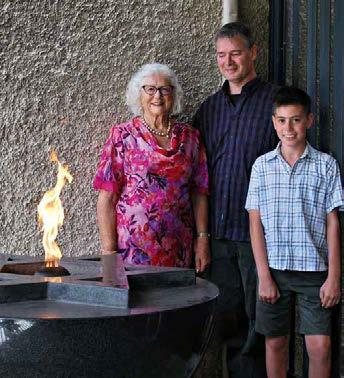
Richard Melzak was born in Warsaw in 1928 and passed away in Melbourne in 2014. Against many odds, he survived the Holocaust. He went on to embrace life to the fullest, never forgetting those he lost and the hardships he endured. He had a strong commitment to philanthropy and would have been proud to see his grandson following in his footsteps.
Devon is keeping the ame alive and safeguarding important memories for future generations. We thank Devon for his generosity and wish his family a hearty Mazal tov
Phillip
Maisel
Testimonies Project
The Jewish Holocaust Centre has over 1300 video testimonies as well as over 200 audio testimonies in its collection. These provide eyewitness accounts of the horrors of the Holocaust, as well as glimpses into the vibrancy of pre-war Jewish life in Europe. The collection is widely used by researchers and students of oral history, the Holocaust and a variety of other disciplines.
If you would like to give your testimony or know of someone who is interested in giving a testimony, contact Phillip Maisel. Phone: (03) 9528 1985 or email: testimonies@jhc.org.au

JHC Centre News 29
(l-r) Margot, James and Devon Melzak
The Melzak family
New acquisitions
Christian, and post-war photographs, including a reunion with her brothers, and her life and family in Israel. Please see the back cover for photograph. Donated by Sarah Saaroni, JHC volunteer guide.
5. Chaim Sztajer Collection

A collection of photographs and documents from the pre- and post-war periods. This donation substantially enhances the documentation of Chaim’s life, and his rare status as one of the 67 people known to have survived the Treblinka Uprising in August 1943. Chaim was a sonderkommando at the death camp for over 11 months, and his model of the camp is one of the central features of the JHC museum. Donated by Malka Zylbersztajn, daughter of Chaim Sztajer.
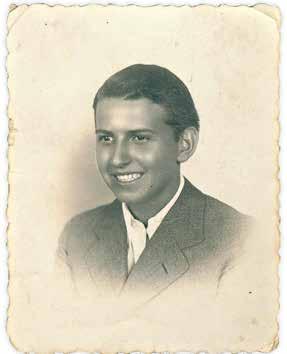
THE FOLLOWING ARE NEW additions to the Centre’s collection from June - December 2017. We are so appreciative of these rare and important historical documents and artefacts that enhance the historicism of the Holocaust, particularly with their Melbourne connections, which makes the Jewish Holocaust Centre (JHC) Collection unique. Thank you to our donors for their generosity, and to donors who have contributed funding to the archival processes. Donations of original Holocaust artefacts are always welcome, and we also welcome donations of originals where copies were previously donated to the Centre. Please contact JHC’s Archivist, Dr Anna Hirsh to make an appointment: annah@jhc.org.au
1. Rudi and Sylvia Cherny Collection
An extensive collection including a suitcase, books, photographs, Kindertransport tags, and documents that provide details of the histories of both families, their escape from Austria, and their immigration to Australia before the outbreak of the Second World War.


Donated by Peter Cherny, son of Rudi and Sylvia, who contributed greatly to the documentation.
2. Arnold Lederman Collection
In addition to photographs of Arnold and his family in pre-war Czestochowa, Poland, this collection includes a number of romantic letters from Arnold’s girlfriends, the fates of some are unknown.
Donated by Joe Lederman, Arnold’s son.
3. Ernest Marcuse Collection
Drawings, sketchbooks, illustrations and documents from the life of Ernest Marcuse: Berlin émigré, artist, designer and Australian War Artist. These include fantastic illustrations from and of pre-war Germany through to the rise of Nazism, as well as a valuable sketchbook charting Marcuse’s journey to Australia. Donated by Peter Marcuse.
4. Sarah Saaroni Collection

Sarah Saaroni has generously donated a photo album which holds precious photographs of her family in pre-war Poland, rare photographs of Sarah during the war when she was working in forced labour with a false identity as a Polish
6. Rosa Sztajer Collection
Rosa Granek, the third wife of Chaim Sztajer, was herself a Holocaust survivor. She was unable to speak of her experiences, suffering and loss of her family in camps including BergenBelsen. After the war, she wrote moving poetry about her experiences and the Holocaust in diaries. The collection also includes photographs and documents from the immediate post-war period. These include some of her husband Srulek Granek, a survivor of Buchenwald. Donated by Malka Zylbersztajn, stepdaughter of Rosa Granek.
7. Edward Ruston Collection
Witness statement by Major Edward Ruston, who was in the British army when the concentration camp at Neustadt in Germany was liberated on 3 May 1945. He describes his encounters with the prisoners. Donated by Jane Fothergill, Major Ruston’s daughter.
30 JHC Centre News
Ernest Marcuse, detail from sketchbook, 1938
Arnold Lederman, Czestochowa, 1936
Rudi Cherny’s suitcase, 1930s
Sabina Josem

1923 – 2017
dorothy Josem
SabiNa Josem (Née ZyskiNd) was aN uNlikely survivor – lucky to have been smuggled out of the Warsaw ghetto and to survive on the Aryan side – but a survivor she most certainly was.
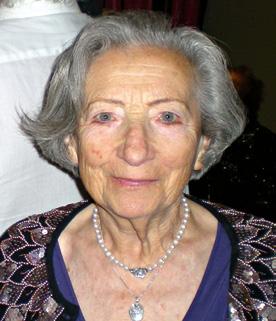
Born into a successful middle-class family in Lodz, Poland, Sabina had an older sister and brother. She adored her parents, particularly her mother. Her education and privileged life, however, came to an end with the outbreak of war.
Sabina witnessed the SS taking her mother, father and brother to their deaths, something from which she never really recovered. Her sister Irene was able to pass as Polish, and was able to organise various hiding places for Sabina after her escape from the ghetto and a period in a labour camp. Despite a bout of pneumonia from which she recovered, albeit without medical treatment and with a severely damaged lung, Sabina survived the war. She and Irene were the sole survivors of the Zyskind family.
After the war, Sabina and Irene returned to Lodz where they established a shop, selling chocolate supplied by the business that the family had owned before the war. By 1947, she had met and married Misha Josem and together they were determined to leave Poland as soon as they were able to do so. They spent a year in Milan, Italy, waiting for a ship to take them to Australia. They had chosen Australia as it was as far from Europe as they could possibly go. Their daughter Dorothy was born in 1947; the family arrived in Melbourne in 1949.
Sabina’s privileged childhood and her education that had been cut
short by the war had left her with few skills other than her innate intelligence and determination to succeed at the task at hand. However, during her time in Milan, she studied sewing, a skill that enabled her to find work when she arrived in Melbourne. She had never learned to cook, so Misha took on that role for some years, becoming well known for his latkes Gradually they built a life together in Melbourne. In 1965 their son Bruce was born.
Throughout the years, Sabina’s health was compromised by the untreated pneumonia she suffered during wartime. Simple coughs would turn into worrying bouts of bronchitis and, occasionally, pneumonia. Each time she would pull through, albeit slightly weakened. Misha died in 1973, leaving her to cope on her own, but with her characteristic determination to survive, she maintained both her home and commercial side of her life. When she finally retired from business, she became a stalwart volunteer at the Jewish Holocaust Centre library where she served for many years. Although devastated by the sudden death of her beloved sister, she survived her by more than a decade, during which time she defied medical opinion by surviving a second broken hip.
It was no accident that Sabina died on the eighteenth day of the month (eighteen signifying life in Hebrew). Her determination to live life to the fullest while at the same time living with a profound sense of loss was legendary. She was a wonderful supportive mother who always put her family first, and was the most loyal of friends. She is much missed.
JHC Centre News 31
Dorothy Josem is Sabina Josem’s daughter.
Kitia Altman
1922 – 2017
Pauline rockman oam
WH eN i first met kitia i N 19 96, i wa s draw N to this articulate, intelligent, elegant and accomplished woman who became a source of inspiration, a mentor and, most of all, a dear friend. s he ta ught me much about the human spirit, about humility and assertiveness, and how to find humanity in a usc hwitz.
Henrietta (Kitia) Szpigelman was born in Bedzin, Poland. She had a comfortable and secure childhood, surrounded by her loving, traditionally Jewish, middleclass family. Although an obedient child, she showed early signs of a strong will and clear ideas about right and wrong.
Kitia was aware of antisemitism, but did not personally experience it before the outbreak of the Second World War. She was 17 when her world changed forever. Forced to abandon plans to study languages in Paris, she was sent to work in a factory producing uniforms for the German Army. There she became friends with a girl called Cesia. When a sealed ghetto was established in 1942, Kitia could have gone into hiding with the family of Polish woman Genia Pajak, but insisted that her niece Maroussia go instead. She also refused to compromise her values and spy on a co-worker for a Jewish official, despite threats to her safety.
For a short time Alfred Rossner, the German factory manager, was able to protect hundreds of Jewish workers, as their work was considered essential for the German war economy. However, the Gestapo later accused him of aiding and abetting Jews and Rossner was hanged in 1944.
After the Bedzin ghetto was liquidated in 1943, Kitia and Cesia were sent to Annaberg labour camp and, from there, to Auschwitz where they were tattooed with consecutive identity numbers, A25440 and A25441, and began to experience real horror. In 1944 they were transported to Ravensbrück where there was little food and they worked in a quarry in the freezing cold. From there they were taken to Bensdorf to work in an underground armaments factory where conditions were much better, as they were not exposed to the cold. One German supervisor even supplied Kitia with extra bits of food.
Kitia and Cesia were fortunate to have each other. Kitia said: ‘[In the camps] you feel that if you die nobody will ever know that you lived. We reminded each other that there was another world. That once we were human beings. In moments of despair we were there to help each other.’
In April 1945 Bensdorf was liberated by the International Red Cross and Kitia was taken to Sweden. Three months later she was reunited with her mother in Paris. They learnt that her father had died on a death march. Kitia married, and she and her husband came to Australia in 1947. Her son Eugene Zablud, who now lives in Israel, was born two years later. In 1970, she remarried. Her beloved husband, Fred Altman, died in 1999.
In 1987 Kitia began volunteering at the Jewish Holocaust Centre (JHC) as a museum guide and interviewer in the testimonies department. She was a passionate and articulate communicator who became a powerful voice for survivors and spokesperson
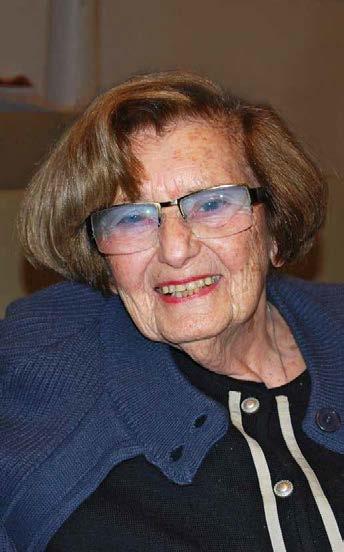
32 JHC Centre News
for the JHC. Like many other survivors, for Kitia the JHC provided a home and family, and a place of commemoration.
In 2003 Kitia published her memoir, Memories of Ordinary People. For her, writing began the long process of confronting the demons of her past. However, she also recognised the humanity and decency of those like Alfred Rossner and Genia Pajak. She was instrumental in both being honoured by Yad Vashem as Righteous Among the Nations and remained a passionate advocate of the Righteous.
In 1993, Kitia debated revisionist historian David Irving on Australian national television, arguing that Irving’s statements insulted ‘the memory of the dead and the decency of the living’. This debate recently featured in the movie Denial.
In 2012 Julia Gillard, then Prime Minister of Australia, visited the JHC. After meeting her, Kitia said: ‘Who would have thought that I, who walked upon the soil of Auschwitz as a young
woman, would one day shake the hand of the Prime Minister of Australia.’ The following year, Kitia was awarded an OAM for service to the JHC and the community.
When Kitia reluctantly retired from the JHC, she continued to maintain an active interest in its work. She said:
No one can make any predictions about the future, but as long as people exist who understand the survivors, and can pass the knowledge and the feelings of the survivors on to others, then the Holocaust will be remembered, both as part of Jewish identity and for its universal importance.
Pauline Rockman OAM is co-president of the Jewish Holocaust Centre. This is an edited version of the eulogy she delivered at Kitia Altman’s funeral.
Fridays with Kitia
Hannah Miska
IC a N still H ear t H e exCiteM eN t i N t H at voi Ce w H eN i heard it the first time. There was a knocking on the door as I sat with the Jewish Holocaust Centre curator discussing a volunteer project, and in came Kitia. When she saw me, she said: ‘Hannele, is that you? I heard there is a German working here at the Centre. Why don’t you come and see us guides in the coffee corner and have a chat with us?’
When I accepted Kitia’s invitation to join her for coffee more than 10 years ago, it marked the beginning of a wonderful friendship. Kitia was still working as a museum guide at the Centre, as well as for the travelling education and exhibition program conducted by Courage to Care. I had the pleasure of listening to her several times when she spoke – articulate, eloquent, without a script.
When I wanted to interview Kitia to learn more about her story, she invited me to her house on a Friday afternoon. When the afternoon had passed I still only knew a fraction of her life. ‘Would I like to come back the following Friday?’ Kitia asked. ‘Yes.’ Our Fridays became an institution. Kitia was a fabulous storyteller with a magnificent sense of humour. And while she talked, and I asked many questions, I learnt not only about Kitia’s life, but also invaluable information about the Holocaust.
Interestingly, she never talked about the graphic horrors of the Holocaust. In her book Memories of Ordinary People, an extraordinary attempt to remember those who perished –family, friends and people who crossed her path – she brilliantly analyses the subtleties of the terror and trauma, the not-soobvious, subliminal, hidden aspects of the Holocaust. To her, the worst aspect of the Holocaust was that the Nazis tried to
eradicate all common laws of human society, including values, beliefs, morals and ethical standards, and that they almost succeeded. The perversion of all human norms in a society haunted her to the very end. She was determined that the lessons learned from the Holocaust be passed on to future generations. Her major concern was to raise the awareness for those people who ‘threw the light of nobility on mankind’: the Chassidei Umot Ha’olam, the Righteous Among the Nations. Kitia wanted them to have a place in our world, to be remembered for their courage and compassion.
When Kitia heard that my publisher had asked me to write a biography of Alfred Rossner, the German manager of a textile factory in B ę dzin who was influential in her survival, she was thrilled, and the telephone line between Munich and Melbourne ran red hot. Kitia gave me much information about Rossner, and read and edited the first 50 pages of the book. At the end of her life, she had not lost one iota of her sharpness, intellect and humour.
I miss Kitia, and would like to conclude as we ended every Friday afternoon – with a glass of brandy and a toast. L’chaim, Kitia!
Dr Hannah Miska was a volunteer at the Jewish Holocaust Centre from 2005 to 2010. She is the author of the book So weit wie möglich weg von hier. Von Europa nach Melbourne – Holocaust-Überlebende erzählen. (As far away as possible: From Europe to Melbourne – Holocaust survivors tell their stories).
JHC Centre News 33
School visits 2017
Over 22,000 students from schools and universities across Victoria, as well as some from interstate and overseas, visited the Jewish Holocaust Centre last year. These are the schools that visited:
Aitken College
Albert Park College
Alexandra Secondary School
Alkira College
Alphington Grammar School
Antonine College
Aquinas College
Ashwood High School
Assumption College
Auburn High School
Ava Maria College
Avila College
Bacchus Marsh Grammar
Ballarat Clarendon College
Ballarat Secondary College
Balranald Central
Balwyn High School
Bayside Christian College
Bayside P-12 College
Beaconhills College
Belmont High School
Bentleigh West Primary School
Berwick Secondary College
Berwick Tec
Beth Rivka College
Bialik College
Billanook College
Birchip P-12 School
Boort District School
Box Hill Secondary College
Braybrook College
Brentwood Secondary College
Bright Secondary College
Brighton Grammar
Brighton Secondary College
Brunswick Secondary College
Carey Baptist Grammar
Camberwell Girls Grammar
Camberwell High School
Canterbury Girls Secondary
Carawatha College
Caroline Chisholm College
Carrum Downs Secondary
Casterton Secondary College
Cathedral College Bendigo
Cathedral College Wangaratta
Catholic College Sale
Catholic Ladies College
Catholic Regional College Melton
Caulfield Grammar
Chairo Christine College
Charlton Secondary School
Cheltenham Secondary College
Christian Brothers College
Citipointe Christian College
Clonard College
Cobram Anglican College
Cornish College
Corowa High School
Craigieburn Secondary College
CRC North Keilor
Damascus College
Dandenong High School
Daylesford Secondary
De La Salle College
Deniliquin Christian School
Derrinallum P-12 College
Diamond Valley College
Dimboola Memorial SC
Donald High School
Doncaster Secondary College
Donvale Christian College
Dromana Secondary College
Drouin Secondary College
East Doncaster Secondary
East Preston Islamic College
Echuca College
Eltham College
Emerald Secondary College
Emmanuel College
Encounter Lutheran College
Echuca College
Firbank College
Fintona College
Fitzroy High School
FJC College
Flinders Christian Community
Footscray City College
Foster Secondary College
Fountain Gate Secondary College
Frankston High School
Geelong Baptist College
Geelong High School
Geelong Lutheran College
Genazzano FCJ College
Gilson College
Gippsland Grammar
Gisborne Secondary College
Gladstone Park Secondary
Glenaeon School
Gleneagles Secondary School
Glen Eira College
Glen Waverley S C
Glenroy College
Good News Lutheran College
Goulburn Valley Grammar
Hazel Glen College
Heathdale Christian College
Highvale Secondary College
Highview College
Hillcrest Christian College
Hopetoun P-12 College
Hoppers Crossing Secondary
Horsham College
Huntingtower
Ilim College
Ivanhoe Grammar
John Fawkner College
John Monash Science School
John Paul College
Kadina Memorial School
Kambrya College
Kaniva College
Kardinia Memorial School
Kew High School
Keysborough Secondary College
Kilbreda College
King David School
Kings Christian College
Kings College Warrnambool
Kolbe College
Koonung Secondary College
Koo Wee Rup Secondary
Kyabram P-12 College
Lakeview Senior College
Lalor North Secondary
Lara Secondary College
Lauriston Girls School
Lavalla Christian College
Leibler Yavneh College
Lilydale High School
Loretto College
Lowther Hall AGS
Loyola College
Luther College
Lyndale Secondary College
Mackillop College
Macleod College
Manangatang P-12 College
Manor Lakes College
Marcellin College
Marian College Ararat
Marist Sion College
Mater Christi College
McClelland College
McKinnon Primary School
Melbourne Grammar School
Melbourne Girls College
Melbourne Girls Grammar
Melbourne High School
Melton Christian College
Melton Secondary College
Mentone Girls Secondary
Mentone Grammar
Mercy College MacKay
Mercy Regional College
Meridian School
Mill Park Secondary College
Mirboo College
MLC
Monivae College
Mooroolbark College
Mornington Secondary College
Mount Clear College
Mount Eliza Secondary
Mount Erin College
Mount Lilydale Mercy College
Mount Ridley P-12
Mount Scopus College
Mount St Joseph’s College
Mount Waverley Secondary
Murtoa College
Nagle College
Narre Warren South SC
Nathalia Secondary
Nazareth College
Newhaven College
Noble Park Secondary
Northern College
Notre Dame College
Nunawading Christian College
Oakwood School
Oberon High School
Our Lady of Mercy College
Our Lady of Sion College
Our Lady of the Sacred Heart
Overnewton Anglican College
Oxley Christian College
Pakenham Secondary College
Padua College Rosebud
Padua College Mornington
Parkdale Secondary College
Pascoe Vale Girls College
Patterson River Secondary
Penleigh Essendon Grammar
Phoenix P-12 College
Princes Hill Secondary College
Reservoir High School
Ringwood Secondary College
Riverside Christian College
Rochester Secondary College
Rosebud Secondary College
Rosehill Secondary College
Rowville Secondary College
Roxburgh College
Rutherglen High School
Ruyton Girls School
Sacre Coeur
Sacred Heart Girls College
Sale College
Salesian College
Santa Maria College
Scotch College
St Aloysius College
St Augustines College
St Bedes College
St Bernard’s College
St Bridget’s College
St Catherines
St Dominic’s Primary School
St Francis Xavier College
St Helena Secondary College
St Johns College
St Josephs College
St Mary MacKillop College
St Mary College
St Mary’s of the Angels
St Peter’s College
Seymour College
Shepparton ACE College
Shepparton High School
Siena College
Southern Cross Grammar
Star of the Sea College
Staughton College
Strathcona BGGS
Strathmore Secondary
Sunbury College
Swifts Creek P-12 School
Swinburne Senior Secondary
Sydney Road Community College
Tarneit Senior College
Temple Christian College
Templestowe College
The Grange P-12 College
The Hamilton & Alexandra College
The Knox School
The Peninsula School
Thomas Carr College
Thornbury High School
Timbarra P-9 College
Tintern Grammar
Trinity College
University High
Upper Yarra Secondary
Upwey High School
Urrbrae Agricultural High School
Vermont Secondary College
Victoria University Secondary
Victory Lutheran College
Wallan Secondary College
Wanganui Park Secondary
Warracknabeal Secondary
Warrnambool High School
Waverley Christian College
Wellington Secondary College
Werribee Secondary College
Wesley College,
Western Port Secondary College
Whittlesea Secondary College
Wonthaggi Secondary College
Woodleigh College
Xavier College
Yarra Hills Secondary
Yarra Valley Grammar
Yarram Secondary College
Yarrawonga College
Yea secondary School
Yeshiva College
34 JHC Centre News
Engagement
To Andy Factor on the engagement of his granddaughter Danielle Kaufman to Farrel Braver
To Judy and Joe Szwarcberg on the engagement of their granddaughter Cara Szwarcberg to Daniel Avrahami
Marriages
To Julie Cohen on the marriage of her granddaughter Amy Cohen to Adam Spicer
To Renata and David Gelb on the marriage of their daughter Hannah Gelb to Marcus Alexander
To John Lamovie on the marriage of his grandson Yossie Jedwab to Ellie
To Tuvia Lipson on the marriage of his granddaughter Jade Lipson to Joshua Zajonc
Mazal tov
To Debbie and Leon Mandel on the marriage of their daughter Lauren Mandel to Phillip Wein
To Judy and Joe Szwarcberg on the marriage of their granddaughter Olivia Szwarcberg to Daniel Kitay
Births
To John Chaskiel on the birth of his great-grandson Arlo Brouze
To Susan Glass on the birth of her grandchildren Sheina and Ari Esakoff
To Cesia Goldberg and Abram Goldberg OAM on the birth of their great-granddaughter Sienna Kuran
To Kathy and Les Janovic on the birth of their granddaughter Indy Janovic
To Ivan Jarny on the birth of his great-granddaughter Jade Grant
Condolences
To Leonie Nussbaum on the birth of her grandson Ezra Genende
To Leah and David Shulberg on the birth of their granddaughter Sienna Shulberg
To Malka and Sam Silver on the birth of their granddaughter Madison Zylberstzajn
Bar/Bat Mitzvah
To Tammy and Chaim Reznik on the occasion of the bat mitzvah of their daughter Shira Reznik
To Floris Kalman on the occasion of the bar mitzvah of her grandson Reuben Rosengarten
To Judy and Michael Wiesner on the occasion of the bar mitzvah of their grandson Charlie Sheezel
To Vivienne Bolaffi on the death of her mother Zelma Rose
To Caroline and Harry Bryce on the death of their father and father-in-law Morry Majtlis
To Tibor Csaky on the death of his wife Ester Csaky
To Bernard Korbman OAM and Cheryl Korbman on the death of Bernard’s daughter Jemima Korbman
To Lauren and David Majtlis on the death of their grandfather Morry Majtlis
To Debbie and Leon Mandel on the death of their brother-in-law and brother Harry Mandel
To Izi Marmur and Eti Marmur on the death of their mother and mother-in-law Valentina Marmur
To Tosca Mooseek on the death of her husband Michael Mooseek
To Eugene Zablud on the death of his mother Kitia Altman OAM
In Loving Memory of
CESIA ISAKOW
11/10/1926 – 04/03/2017
Born in Chrzanow, Poland, died in Melbourne, Australia. Cherished and devoted mother of Caroline, Glenda and Daniel. Respected mother-in-law of David, Sam and Joanna. Loving grandmother of Sam, Jacqui and Ava
A Holocaust survivor
JHC Centre News 35
Many thanks: Jewish Holocaust Centre and Jewish Holocaust Centre Foundation supporters
We would like to express our sincere gratitude and appreciation to all our donors – your support has made a significant impact and continues to allow us to preserve Holocaust memory and teach the important lessons of the Holocaust.
The listing includes donations to the Foundation or the Jewish Holocaust Centre of $500.00 and above from 1 January 2017 to 1 January 2018.
Michael & Helen Abeles
Dion & Sandy Abrahams
Leonie Allan
Roseanne Amarant
Jeffrey Appel OAM & Sue Appel
David Bardas AO
Judy Becher
Besen Family Foundation
Binks & Associates Pty Ltd
Greg & Julie Blashki
Daryl Blashki & Lynn Trayer
Joey & Julie Borensztajn
Tom & Nuritt Borsky
Evelyn Bresner
Joe & Pam Bursztyn
Eve Casper
Trevor & Heather Cohen
Jimmy Cui
Ron & Judy Dodge
Jack Ekstein
Alan & Yvonne Feil
Warren Fineberg & Vivienne Elton
The Leo & Mina Fink Fund
Alan Finkel AO & Elizabeth Finkel
AM
Joe & Glenda Flinkier
Fonda Family Foundation
Ronit Fraid
Peter & Anita Frayman
Gandel Philanthropy
Mark & Judy Gandur
Ian & Rita Gelbart
Leigh & Yvonne Goldbloom
Leon Goldman
Graham & Deborah Goldsmith
Alan & Pam Goldstone
Philip & Raie Goodvach
Robert & Pauline Grodski
Michael & Evelyn Gross
Joseph Grynberg
Ed & Ada Gurgiel
Lusia Haberfeld
Dennis & Suzanne Hain
George Halasz
Bernie & Melma Hamersfeld
Lawrence & Gene Harris
Gary & Sue Hearst
Joseph Hellen
Ms A Holan
Rachel Hornung
Peter Irving & Marjan Erlanger-
Irving
Paul Ivany & Susie Ivany OAM
Jetmaster (VIC)
Charles & Leah Justin
Floris Kalman
Allan & Sue Kalus
Larry & Petra Kamener
Joseph Kaufman
Ashley Kausman & Lisa Mann
Andrew Kaye AM & Judy Kaye
Irvin Kaye
Jeffrey Kelson
Stephen & Suzie Kleid
Ken & Carol Klooger
David & Bindy Koadlow
Steven Kolt & Frances Prince
Larry & Sophie Kornhauser
Alan & Roxanne Kozica
Dinah Krongold
Sue Krongold
The Landman Foundation
Mr & Mrs L Laszlow
Silvana Layton
Sylvie Leber
Amanda Leibovich
Ron & Shirley Lesh
Michael Levick
The George Lewin Foundation
Phil & Sue Lewis
Eva Light
Rena Lipton
Lowe Lippman Charitable Fund
Karin MacNab
Arnold & Dani Mahemoff
Jeffrey Mahemoff AO & Helen
Mahemoff
Joe & Gisella Mel
Margot Melzak OAM
Richard & Melissa Michaels
Henry Miller & Natalie Miller AO
Abe & Doris Montag
Mark & Den Montag
Justin & Annette Nankin
Dorothea Nossbaum
Barry Novy OAM & Sue Selwyn
Tom Osborne & Judy Rassaby
Gerard & Lil Pearce
The Pearce Family Foundation
Gary & Hana Peer
Harry & Rita Perelberg
Norman Pollack JP
Evelyn Pose
David Prince
Leon & Karen Pruzanski
PSN Family Trust
Sam Recht
Alan Reid & Elly Brooks
Reid Malley Foundation
Ralph & Ruth Renard
Michael & Nicole Rich
Myron Rogers
Richard Rogers & Roslyn Rogers
OAM
Jack & Annette Rosen
Helen Rosenbaum
Julian & Vivien Rosenfeld
Simcha Donations
David & Pauline Rubinstein
William Sasse & Barbara Fih
Peter Schnall
Sam & Judy Seigel
Ada Selwyn
Danny & Anita Selzer
Leon Serry AM & Vivienne Serry
Nathan Shafir OAM & Ruth Shafir
Greg Shalit & Miriam Faine
Gerald & Lorraine Shapiro
Jack & Lesley Silberscher
Barry Singer & Ms Simone SzalmukSinger
The Jack & Robert Smorgon
Families Foundation
The Victor Smorgon Charitable Fund
Helen Sokolski
Graeme Southwick OAM & Suzanne
Southwick
Fleur Spitzer
John & Suzanne Steiner
Bernie Stone
Sunraysia Foundation
Theo & Shirley Sweet
Paul Sztolcman
Regine Szmulewicz
Joe & Judy Szwarcberg
Ron & Sarah Tatarka
Frank Tisher OAM & MiriamTisher
Vicki Vidor
Victor Wayne & Karen Wayne OAM
Sam Webb
Vivien Wertkin
Dennis & Tauba Wilson
Colin & Roe Wise
Leon & Nancy Worth
Jeffrey Zajac
We are pleased to add our Mazal tov to the following people who requested gifts to the Jewish Holocaust Centre and the Jewish Holocuast Centre Foundation in lieu of gifts on their special occasion (from 1 January 2017 to 1 January 2018).
Cody de Bortoli Bar Mitzvah
Devon Melzak Bar Mitzvah
Elaine Ptasznik 60th Birthday
Reuben Zylberszpic 60th Birthday
Allen Brostek 70th Birthday
Jack Ginger 70th Birthday
George Golvan 70th Birthday
Phillip Grosman 70th Birthday
Maurie Kohn
Ilona Oppenheimer
Pauline Rockman
Sara Rosenberg
Ruth Wein
Rena Lipton
Joe De Haan
Rose & Colin Wise
70th Birthday
70th Birthday
70th Birthday
70th Birthday
70th Birthday
80th Birthday
95th Birthday
50th Wedding Anniversary
We apologise if your name has been omitted. Please contact the Centre on 9528 1985 or email admin@jhc.org.au with your details for inclusion in the next listing.
36 JHC Centre News
Regina Adelfang
Anonymous














































Erika Bence












Elza Bernst
Susan Blatman
Gitla Borenstein
Joseph Brown AO OBE
Majer Ceprow
Richard Charlupski
Bertha Fekete
John Fox
Jakob Frenkiel
Cecilia Freshman
Romana Frey
Sara Frucht
Walter Geismar
Fania Gitein
Estate Gifts
We acknowledge the Jewish Holocaust Centre and Foundation bequestors for their generosity and vision.












May their memory be a blessing.
Samuel Gnieslaw
Arnold Hacker
Bessie Heiman
Mendel Herszfeld
Magda Horvat
Sabina Jakubowicz
Betty Janover
Basia Kane
Thea Kimla
Lola Kiven
Leslie Klemke
Izabella Krol
Eva Rivka Knox
Pinek Krystal
Nona Lee
Ivor Leiser
Ruth Leiser
Charlotte Lesser
Kurt Lewinski
Sara Liebmann
Julek & Ada Lipski
Abram Malewiak
Janina Marcus
Don Marejn
Anna Mass
Sonia Mrocki
Victor Muntz
Kalman & Elka Bajla Parasol
Edith Peer
Elizabeth Peer
Lilian Renard
Gerda Rogers
Beatrice & Rose Rosalky
Hadasa Rosenbaum
Shmuel Rosenkranz
Szmul Rostkier
Bencjan Rozencwajg
Shmuel Rosenkranz
Irene & Ignacy Rozental
Leslie Sandy
Joseph Scharf-Dauber
Helen Sharp
Otto Shelton
Raymond Harry Schiller
Marianne Singer
Sara Smuzyk
Owsiej Sokolski
Mary Starr
Georgette Steinic
Samuel Stopnik
Berta Strom
Sonia Suchodolski
Geoffrey Tozer
Josef Tyler
Chana Annette Uberbayn
Emanuel Wajnblum
Kathe Weisselberg
Ludvik Weisz
Hannah Wiener
Pinkus Wiener
Sabina Winter
Ludwik & Rita Win eld
Chaya Ziskind
So a Zitron
Become a Partner in Remembrance

The Jewish Holocaust Centre Foundation ensures the continued existence of the Centre and supports its important work. Funds raised through the Foundation are invested, with the earnings providing an ongoing source of income for the Centre to support its operations and programs into the future.
For more information on how you can help support the Foundation and how your support will be recognised, please contact Helen Mahemoff, Chair of the Foundation on 0417 323 595 or email: jhcfoundation@bigpond.com
JHC Centre News 37


























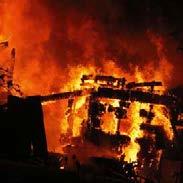


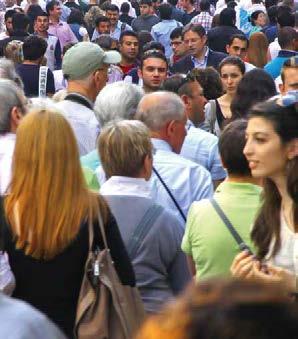

38 JHC Centre News

JHC Centre News 39

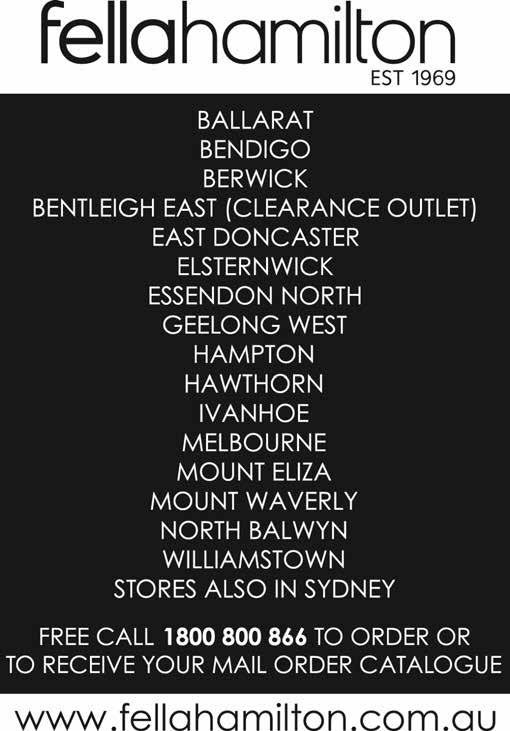



40 JHC Centre News ADVERTISING If you would like to advertise in this section please contact Evelyn Portek Email: EvelynP@jhc.org.au Phone: (03) 9528 1985
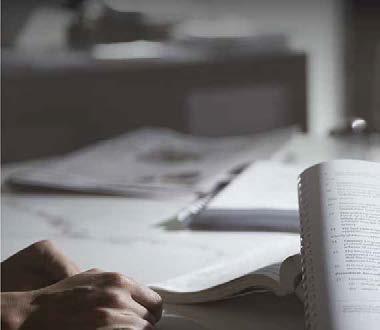






JHC Centre News 41
ץונוצ ייז טעוו סע זַא
טביולגעג םינפּ
ַא ןבָאה ייז
יד ןבָאה טנַאקַאב יוו .םייה רעַײנ רעייז ןיא ןעמוק
יד ןצעזַאב וצ העדב ןבָאה ייז זַא טגָאזעגוצ ןשטַײד
ייז ןענעגרה הלילח טשינ ,ןטיבעג־חרזמ יד ןיא ןדִיי
ןשטַײד יד סָאוו לטימ רעטסעב רעד זַא ,סע טסייה
ןדִיי יד ן
געק המחלמ רעייז ןיא טגָאמרַאפֿ ןבָאה
ןעקנַאט רעדָא ןענַאלפָּארע ןייק ןעוועג טשינ ןענעז עדנַאגַאפָּארפּ עשירענגיל רעייז רָאנ
.
ןשטַײד יד רעקידתועיבֿצ רעייז טימ ןעוועג ךישממ ןבָאה .ףוס ןזיב עדנַאגַאפָּארפּ
ןבָאה ייז סָאוו םעד ךָאנ ןיא ןדִיי ןָאילימ לטרעפֿ ַא ךרע ןַא טזַאגרַאפֿ בָּאס ןוא רעגַאל םעד טרעטשעצ ייז ןבָאה רָאבּי ןעזסױא לָאז סע ,טרָא ןַײז ףיוא רעמייב טצנַאלפֿרַאפֿ
טשינ טלעוו רעד ףיוא לָאמ ןייק זיא רעגַאל רעד יװ ןעוועג.
העדב טָאה גָאלָאעכרַא רעקידלארשׂי רעד
ז ידכּ םישודק יד ןופֿ החפּשמ יד ןכוז וצ י ןלָאז י
םיבֿורק ערעייז —
ףיוא שידק ןגָאז ןעמוק
רשפֿא רעגַאל ןקילָאמַא םענופֿ חטש ןפֿיוא וליפַֿא .
ןגעוו
רעמוז ןיא ָאטעג רעד ןופֿ עיצַאדי
קיל רעד תעשב וו
1942 ןופֿ רעדילגטימ יד ןבָאה
„
תבש גנוע ” ענעלַאטעמ ןעצ ןיא ןטנעמוקָאד יד ןטלַאהַאב
ןבָאה ייז סָאוו ןענַאק־ךלימ ייווצ ןוא סעקשופּ
עקיזָאד יד ןופֿ לייט ַא
דרע רעד ןיא ןבָארגַאב .
רעד ךָאנ ןרָאוועג ןבָארגעגסיוא זיא ןטנעמוקָאד
ןופֿ ןטימ ןיא עקַאט טייטש ןַאק־ךלימ ןייא .המחלמ גנולעטשסיוא רעקיטנַײה רעד „
ןבָאה רימ סָאוו
טלעוו רעד רַאפֿ ןעַײרשסיוא טנעקעג טשינ ”
ַא זיא רעטעברַאטימ רעגנוי ַא ,רעבַארג דוד ןופֿ טַאטיצ םענופֿ „ תבש גנוע ” וויכרַא. זיא סָאוו ײרשעג סָאד ןטנעמוקָאד ענעבָארגַאב יד טימ ןרָאוועג טקיטשרעד
ןכליה טעוו ןוא ןרָאוועג טרעהרעד ָאי עקַאט זיא תורוד רוד רַאפֿ .
דייר ַא טייג סע 5 טימ ןדליש ןרָאוועג טעדרָאמרעד ןענעז סָאוו ןדִיי ןופֿ ןעמענ
ןבָארגעגסיוא.
ןטמירַאב קירעיורט םעניא
. רעקידלארשׂי רעד ,ימייח םרוי
םעד טגָארט לדליש ןייא זַא ןעמָאנ .M. NUNES VAZ
טשינ ךיז טָאה ימייח
רעד טָא ןגעוו עיצַאמרָאפֿניא ןענופֿעג ןוא טליופֿעג .רעכיב־רוכּזי עשידנעלָאה יד ןיא החפּשמ
ריאמ
םַאדרעטסמַא ןיא ןרָאוועג ןריובעג זיא זַאוו סענונ
םעד 19 ַײמ ןט 1899 יא זַאוו סענונ סוקרַאמ ןוא ז
םעד םַאדרעטסמַא ןיא ןרָאװעג ןריובעג 29ןט רעבָאטקָא .1878
טעדרָאמרעד ןענעז עדייב
םעד רָאבּיבָּאס ןיא גָאט ןבלעז םעד ןרָאוועג 4 ינוי ןט 1943 ףיוא ןעגנָאהעג אמתּסמ טָאה לדליש סָאד
.םַאדרעטסמַא ןיא הריד סעזַאוו סענונ ןופ ריט רעד
ןשירָאטסיה ןשידִיי םעניא גנולעטשסיוא עַײנ ַא :עשרַאוו ןיא טוטיטסניא ’ תבש גנוע "’— רימ סָאוו טלעוו רעד רַאפֿ ןעַײרשסיוא טנעקעג טשינ ןבָאה .‟ „ ‟תבש־גנוע וצ הָאנה הווצמ יד ,ןסייוו רימ יוו ,זיא
.תבש ןקילייה םענופֿ ןבָאה
ךיוא זיא תבש־גנוע לאונמע רעקירָאטסיה םענופֿ וויטַאיציניא יד ןעוועג
םעד ןוא ןבעל סָאד ןריטנעמוקָאד וצ םולבלעגניר
.ָאטעג רעוועשרַאוו רעד ןיא ןדִיי יד ן
ופֿ םוקמוא
ןטנעדוטס ןוא סרעוט־ללכּ ,סרערעל ,ןטַארעטיל
עקידנעמוק יד ידכּ ןלַאירעטאמ טלמַאזעג ןבָאה
רעד ןגעוו ףירגַאב ןעיונעג ַא ןבָאה ןלָאז תורוד
ןשידִיי םעד ןלַאפַֿאב זיא סָאוו עידעגַארט רעסיורג
ָאטשטפּיוה רעשיליופּ רעד ןיא קלָאפֿ רעד תעשב ט המחלמ־טלעוו רעטייווצ
42 JHC Centre News
,ץרעווראָפֿ ,רענצײַוו יבאָק ןופֿ 9.01.2018 ןופֿ ךשמבּ טקעדַאב ייז טָאה דרע יד 70 סע זיב רָאי ַא ,ןגָאלָאעכרַא ַײרד ןעמוקעג ןענעז ן ַא ,ילארשׂי ייז ןבָאה ןוא רעדנעלָאה ַא ןוא קַאילָאפּ
רעגַאל־גנערבמוא
דרע רעד ןיא ןענופֿעג ,רָאביבָאס ןיא טכַארבעגמוא ןדִיי ןופֿ ןעמענ טימ ןדליש
ןגעוו
רָאבּיבָּאס
טלייצרעד גָאלָאעכרַא
גנולעטשסיוא
,ץרעווראָפֿ ,רענצײַוו יבאָק ןופֿ
עשרַאוו ןיא
עַײנ „תבש־גנוע‟ וויכרַא
9.01.2018
.
טעוועטאַרעג טאָה סאָוו טאַמאָלפּיד רעשיראַצ
עגראַפֿ רענעײַרעדסווש
ןברוח ןתעב ןדיִי רעטנזיוט
ןופֿ BBC News 4/01/2018
וצ ץוש רעשיראַצײַווש
ןעקנעש ןביוהעגנאָ טאָה רע
גנודניבראַפֿ אַ סעפּע טאַהעג טאָה סאָוו םענייא ןדעי
.טלעטשעגראָפֿ טאָה רע עכלעוו רעדנעל יד טימ
ןיא ןדיִי רעמ ןעוועטאַר ןענעק וצ ידכב רעבאָ
טאָה רע .רעמ ןאָט טזומעג זטול טאָה טשעפּאַדוב
רעבאָ .ווירב ץוש
ןביולרע םיא ןלאָז ייז ןשטײַד יד טגייצעגרעביא ןעקנעש 8,000 עשיטאַמאָלפּיד
ןעוועטאַר וצ טשינ ווירב יד טצונעג רע טאָה ןאַד זיא רע ןעוו ןוא .תוחפשמ עצנאַג ראָנ ,םידיחי זיולב
טאָה רעכלעוו טאַמאָלפּיד
רעשיראַצײַווש אַ
סגנוטער עליוויצ עטסערג יד טריפֿעגכרוד טשרמולכּ
ןוא המחלמ טלעוו רעטײַווצ רעד ןופֿ ךשמב עיצקאַ
טניולאַב טאָטשנאַ זיא ,ןדיִי רעטנזיוט טעוועטאַרעג
יוו טעמכּ זיא ןוא ןראָוועג טפֿאָרטשאַב ,ןרעוו וצ
רעד ןופֿ טאָטשראָפֿ אַ ןיא .ןראָוועג ןסעגראַפֿ
ײַווש אַ ךיז טניפֿעג ,ןרעב טאָטשטפּיוה רעשיראַצ
ןעמ ביוא .געוו זטול לראַק ןעמאָנ ןטימ לסעג ליטש
רענייק טסײַוו סרעייגײַבראַפֿ עקיטראָ יד טגערפֿ
טרירעמונ ווירב םוצ ןעגנאַגרעד
7,999 רע טאָה ןופ ןביוהעגנאָ רעדיוו 1 ןשטײַד יד זאַ קידנפֿאָה , יוזאַ .ווירב עטלפּאָד יד ןקרעמאַב טשינ ןלעוו וא ןענעכער ,טעמוראַ לראַק טאָה רעקיראָטסיה סי ךרע ןאַ'ב טעוועטאַרעג זטול 62,000 יד ,ןשטנעמ רעד תעב רעליוויצ ןופֿ עיצקאַ סגנוטער עטסערג ןיא ןטאַמאָלפּיד ערעדנאַ .המחלמ טלעוו רעטייווצ
רעטסואוואַב רעד טנכערעגנײַראַ ,טשעפּאַדוב ןבאָה גרעבנעלאַוו לואַר רעטער ןדיִי רעשידעווש ונעג ןוא זטול ןופֿ טנרעלעג
סגנוטער ענײַז טצ ןביוהעגנאָ ךיז טאָה ײַמראַ עטיור יד ןעוו .ןעלטימ
ןסיש ןביוהעגנאָ ןבאָה ןשטײַד יד ןוא ןרעטנענרעד
ךײַט ןיא סרעפּרעק ערעייז ןפֿראַוונײַראַ ןוא ןדיִי ,ערעדנאַ ןוא גרעבנעלאַוו ,זטול טאָה ,בוינעד טריזינאַגראָ 120 טשעפּאַדוב םוראַ ןשינעטלעהאַב
ןסור יד ןופֿ גיז ןכאָנ .
ווירב ץוש יד טימ ןדיִי ראַפֿ
ןליופֿאַב ןזטול ןעמ טאָה טשעפּאַדוב ןיא
אַ טאָטשנאַ רעבאָ .ץײַווש ןייק ךיז ןרעקוצקירוצ
ןײַז ראַפֿ גנונעקרענאַ ןוא גנוסירגאַב
ןבאָה ראַפֿ ןראָוועג ןפֿאָרטשאַב רע זיא
ןענײַז ,רעטעפּש טשרע .תושר ןײַז ןטאָרטעגרעביא
נעקרענאַ םישׂעמ סגנוטער עסיורג ענײַז ןראָוועג ט יד ןוא ןראַגנוא ,דנאַלשטײַד ,לארשי ךרוד
טעוו ראָי ןקידנעמוק םעד ןוא ,ןטאַטש עטקינײַראַפ
רעשיראַצײַווש רעד ןופֿ עדייבעג רעד ןיא רעמיצ אַ זטול לראַק ואוו ,גנולייטפּאָ םינינע עכעלרעסיוא
...ןעמאָנ ןײַז ןגאָרט ךיוא ,טריטמאַ טאָה רענפֿאַד סקעלאַ ךרוד טלעטשעגנעמאַזוצ
םעד טנעייל עמ זאַ רעבאָ ,םיא ןגעוו ךס אַ טשינ
,ןעמאָנ ןײַז טימ דליש ןבענ טפֿירשפֿיוא םעניילק
רעשיראַצײַווש :טבײַרש סע .גנונא ןאַ ןעמ טמוקאַב עציוו- ,טשעפּאַדוב ןייק לוסנאָק 1942זיב 1945.
רעד ןיא םיא ןגעוו םיטרפּ רעמ ןאַראַפֿ עכעלרעסיוא ראַפֿ גנולייטפּאָ רעשיראַצײַווש
רעטנזיוט טימ רעדנעב ןאַראַפֿ ןענײַז ןטראָד .םינינע ןופֿ גנוריגער רעד ןופֿ לפּמעטש אַ טימ רעדעי ,ווירב ןופֿ סעיפֿאַרגאָטאָפֿ טימ רעדעי ןוא ,ץײַווש סאָד .תוחפּשמ לראַק ןופֿ ןשינעכייצראַפֿ יד ןענײַז עשיצאַנ יד ןלעטשפּאָ וצ ןעגנוימאַב סזטול וצ טשעפּאַדוב ןופֿ ןדיִי רעטנזיוט ןופֿ סעיצאַטראָפּעד טאַמאָלפּיד רענעראַפֿרעד אַ יוו .ןרעגאַל ןטיוט יד לוסנאָק רעשיראַצײַווש רעד יוו טנידעג זטול טאָה יד ןיא טלאָמעד ,עניטסעלאַפּ ןייק
1930 אַ ןראָי עק ןופֿ טאַדנאַמ
טקישעגרעביא זיא רע .עינאַטירב ראָי ןיא טשעפּאַדוב ןייק ןראָוועג
1942 םעד ךאָנ ןופֿ טײַז רעד ףיוא גירק ןיא ןײַראַ זיא ןראַגנוא יוו ראָי ןיא רעבאָ .ןשטײַד יד
1944 ןשטײַד יד ןבאָה
ןדיִי ןופֿ סעיצאַטראָפּעד יד ןוא ןראַגנוא טריפּוקאָ
ןוא םעד ךאָנ ףכּיתּ ןביוהעגנאָ טאָה ץיוושיוא ןייק זטול .לענש סעפּע ןאָט זומ רע זאַ ןענאַטשראַפֿ טאָה
טאָה ץײַווש רעלאַרטוענ רעד ןופֿ רעייטשראָפֿ אַ יוו ערעדנאַ ןופֿ ןסערעטניא יד טלעטשעגראָפֿ ךיוא זטול ערעייז טכאַמראַפֿ ןבאָה עכלעוו רעדנעל
יד טנכערעגנײַראַ ,ןראַגנוא ןיא סעדאַסאַבמאַ
.עינאַטירב ןוא ןטאַטש עטקינײַראַפֿ
JHC Centre News 43
,טייקשידלעה
OUR VITAL MISSION: PRESERVING THE EVIDENCE OF THE HOLOCAUST





We are committed to caring for the fragments of evidence that remain of a lost world and a horri c time in history.


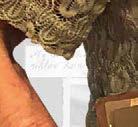

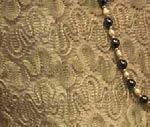
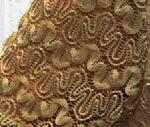
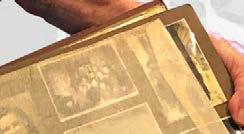
By donating your Holocaust-related artefacts to the Jewish Holocaust Centre, we can protect these items in a professional archive, as well as share their contents with a wider audience, for educational and research purposes.
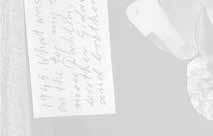


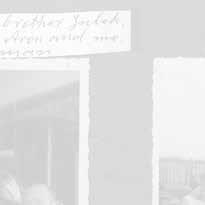

Your family’s stories will be preserved and honoured when you donate their artefacts to the JHC.

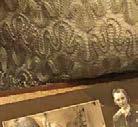

Please call Dr Anna Hirsh, Archivist, to arrange an appointment on (03) 9528 1985
















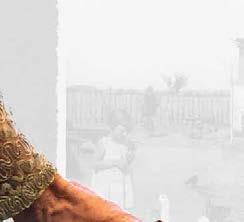





 Sarah Saaroni with the photo album she has donated to the JHC
APRIL 2018 The magazine of the Jewish Holocaust Centre, Melbourne, Australia
Sarah Saaroni with the photo album she has donated to the JHC
APRIL 2018 The magazine of the Jewish Holocaust Centre, Melbourne, Australia







































 Ber N adette Gore: Fra NCe
Ber N adette Gore: Fra NCe




















 Michael Cohen
Michael Cohen






























































































 Sarah Saaroni with the photo album she has donated to the JHC
APRIL 2018 The magazine of the Jewish Holocaust Centre, Melbourne, Australia
Sarah Saaroni with the photo album she has donated to the JHC
APRIL 2018 The magazine of the Jewish Holocaust Centre, Melbourne, Australia